Do you only have a day in Athens? Maybe you're just passing through on the way to the Greek islands and wondering is Athens worth visiting? Or maybe you've already decided to visit, but are wondering how many days you need in Athens? Well read on, and we'll show you how to see Athens in a day and how to make the most of your visit...
We step out of the metro station into the cool night breeze, but the welcome is warm with a real buzz all around us. We stop and take it all in, looking around to get our bearings, and there it is shining bright against the dark night sky... the Parthenon atop the Acropolis!
It's late on Friday night when we arrive in Monastiraki Square but it's still crowded with locals and tourists loitering around, market sellers trying to make their last money of the day, and music playing from the busy tavernas filled with diners enjoying a late night meal.
We're feeling weary after a long days travel, but we're re-energised by the atmosphere and from seeing the Acropolis shining bright... so after finding our apartment and dropping our bags, we head back out and join the diners in the square.
Our first authentic kebab melts in our mouth and we wash it down with a refreshing ice cold Mythos beer, before heading back for some much needed rest.
With so much to see and do and wanting to see Athens in a day and make the most of our visit, we're booked onto an early morning walking tour of Athens provided by Walks, which you can book yourself here... Athens In a Day Tour.
 The house special Thanasis kebab
The house special Thanasis kebab  Stepping out of Monastiraki metro station, what a greeting!
Stepping out of Monastiraki metro station, what a greeting! 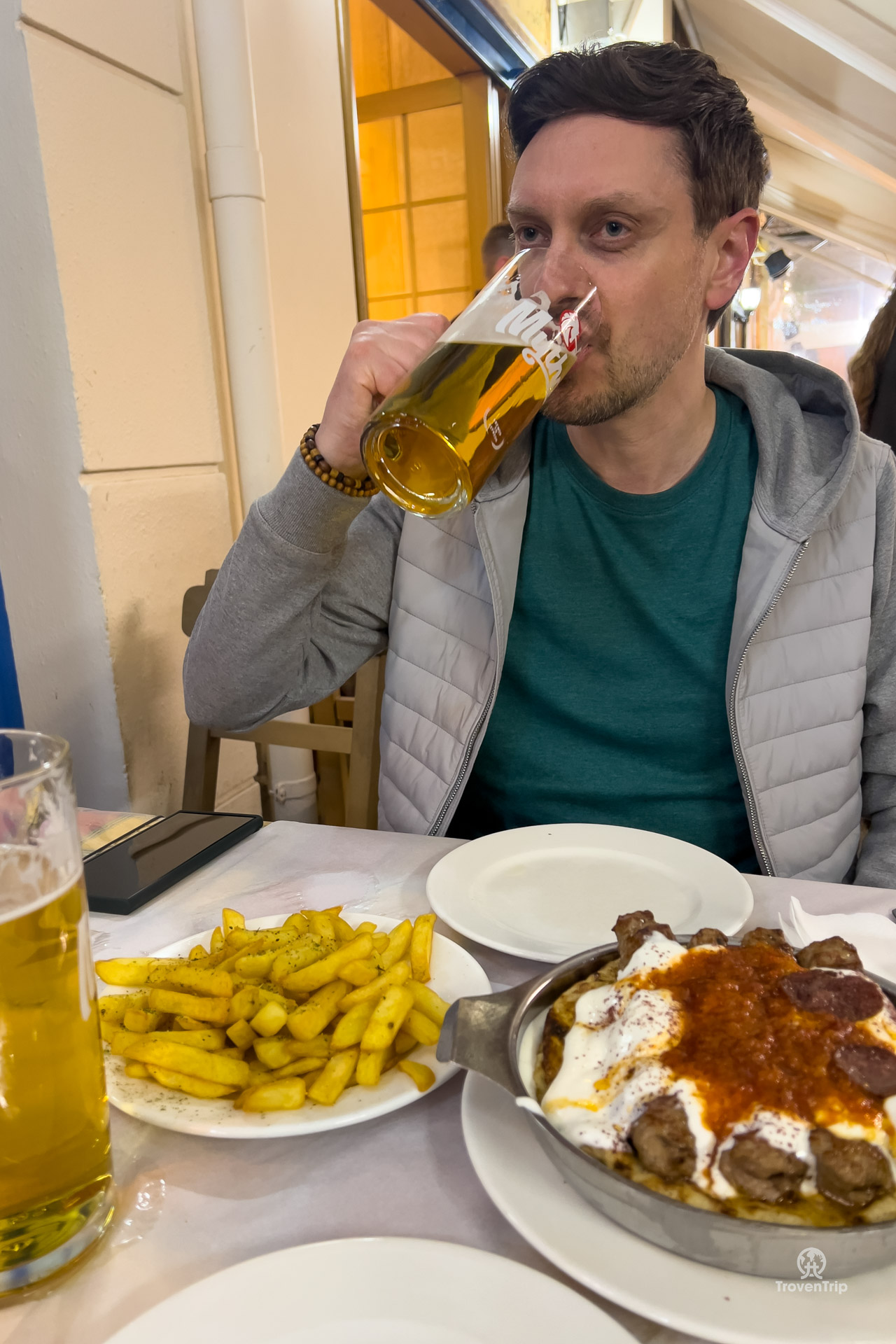 A much needed ice cold beer
A much needed ice cold beer  The first Mythos of the trip
The first Mythos of the trip The tour covers all of the below, meaning you really do get to see Athens in a day and make the most of your visit...
- The UNESCO World Heritage Site the Acropolis of Athens
- Shrine & Theatre of Dionysus
- Odeon of Herodes Atticus
- Monumental Gateway of the Acropolis
- Parthenon
- Temples of Erechtheum & Athena Nike
- Ancient Greek Agora of Athens
- Stoa of Attalos & Temple of Hephaestus at the Agora
- Roman Agora, Tower of the Winds & Gate of Athena Archegetis
- Plaka Old Town
- New Acropolis Museum
- Parthenon Marbles
- Caryatids of the Acropolis & Archaic Acropolis Gallery
- Panathenaic Stadium... Birthplace of the Modern Olympic Games
Check out the 1 min trailer video!
Acropolis of Athens
Where else to start our day other than at the Acropolis... the must see sight in Athens!
Home to the most famous landmark in Athens, the birthplace of democracy, philosophy and theatre, the huge hill dominates the city skyline. And being regular visitors to castles and ruins at home in the UK, the chance to immerse ourselves in the history of the ancient city is a perfect starting place for us!
Our morning doesn't get off to the best start though... Paul falls into the typical tourist trap and, still being half asleep, forgets to agree a price with the taxi driver or make sure the meter is running!
2km and €20 later (rookie mistake), we reach our meeting point at Acron Café in time to get a coffee and takeaway chicken spanakopita to try and wake us up a little before our tour starts (which we highly recommend doing, both were delicious!).
We get set up with Bluetooth earphones so we can hear the tour while also being able to wander on our own. A few of the other people on the tour have issues with the earphones, but our guide and support team go to great efforts to quickly resolve the problem and make sure everyone is working before we start the tour... quite impressive and a quick turnaround!
 Getting set-up with our Bluetooth earphone
Getting set-up with our Bluetooth earphone  All ready for our Walks Tour
All ready for our Walks Tour  We don't need this we have an expert guide to show us around!
We don't need this we have an expert guide to show us around! 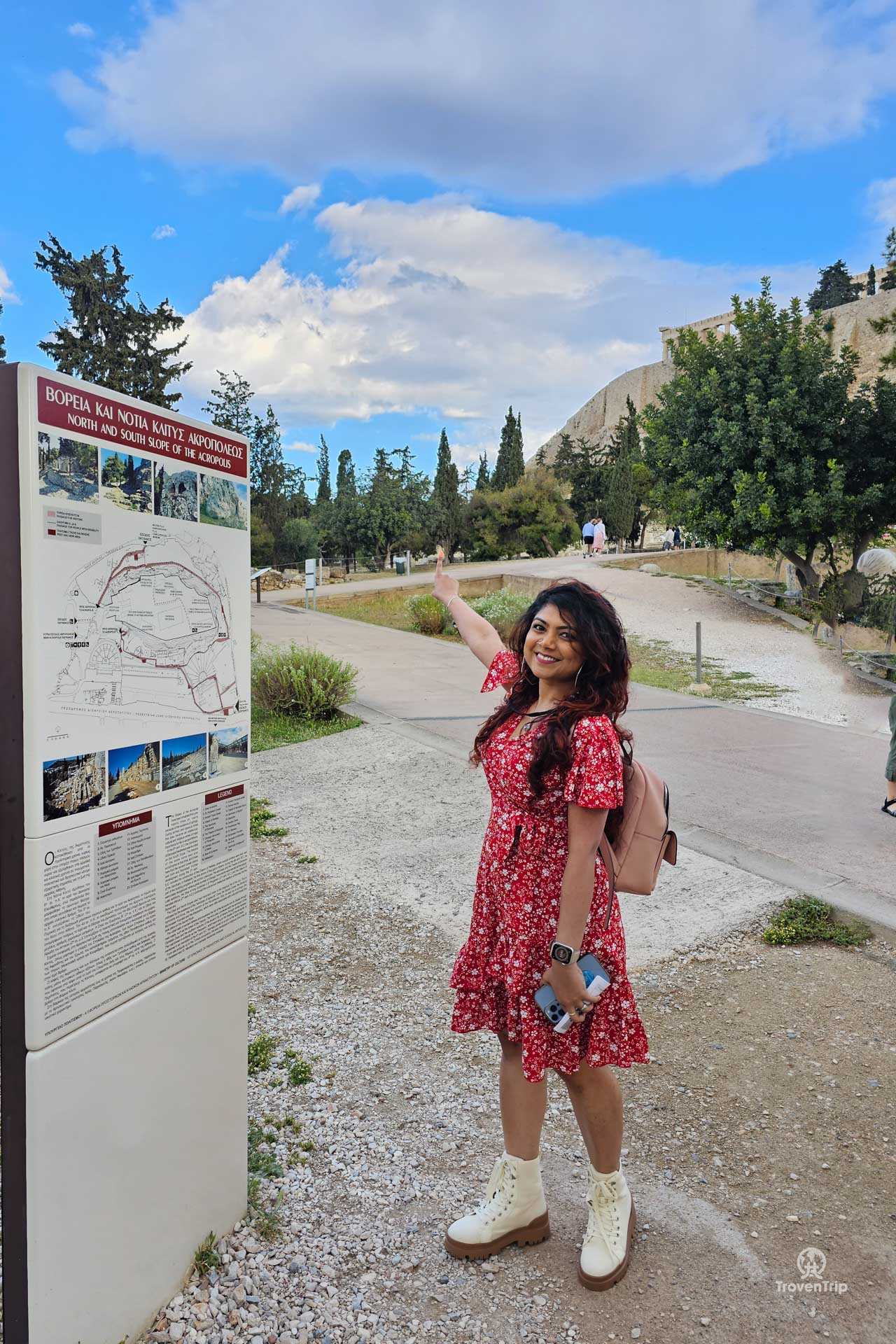 I think it's that way...
I think it's that way... Our guide for the day is Sophia Kantzia and she starts to explain the history of Athens and the Acropolis, as well as asking Paul if he has Greek heritage as the name Harris is apparently a common one in Greece (it has the meaning "joy" and "to shine", very apt for anyone who hasn't met me 
We have skip the line tickets as part of our tour so we head straight in (a nice benefit to help make the most of our time), and start our journey through 3,500 years of history...
Shrine & Theatre of Dionysus
Our first stop once inside is at a sacred shrine dedicated to Dionysus, the god of wine, fertility, and theatre. One of the oldest parts of the Acropolis, had we not been on the tour, we think we would have walked straight past the small stone circle under an olive tree and not noticed it.
Just behind the shrine is the Theatre of Dionysus, one of the oldest and most important theatres in the Western world. This is where theatre started with the birth of tragedies and comedies, and was the centre for cultural and artistic expression. At it's peak it could hold 17,000 spectators, although little remains of the once great theatre now.
Standing where the stage would have been, looking up at the rows of seats rising in front of us, we try to imagine what it would have been like all those years ago performing the very first plays for the people of the city (and maybe the cats... there are cats everywhere, something we get very used to during our time in Greece!).
 The sacred shrine to Dionysus
The sacred shrine to Dionysus 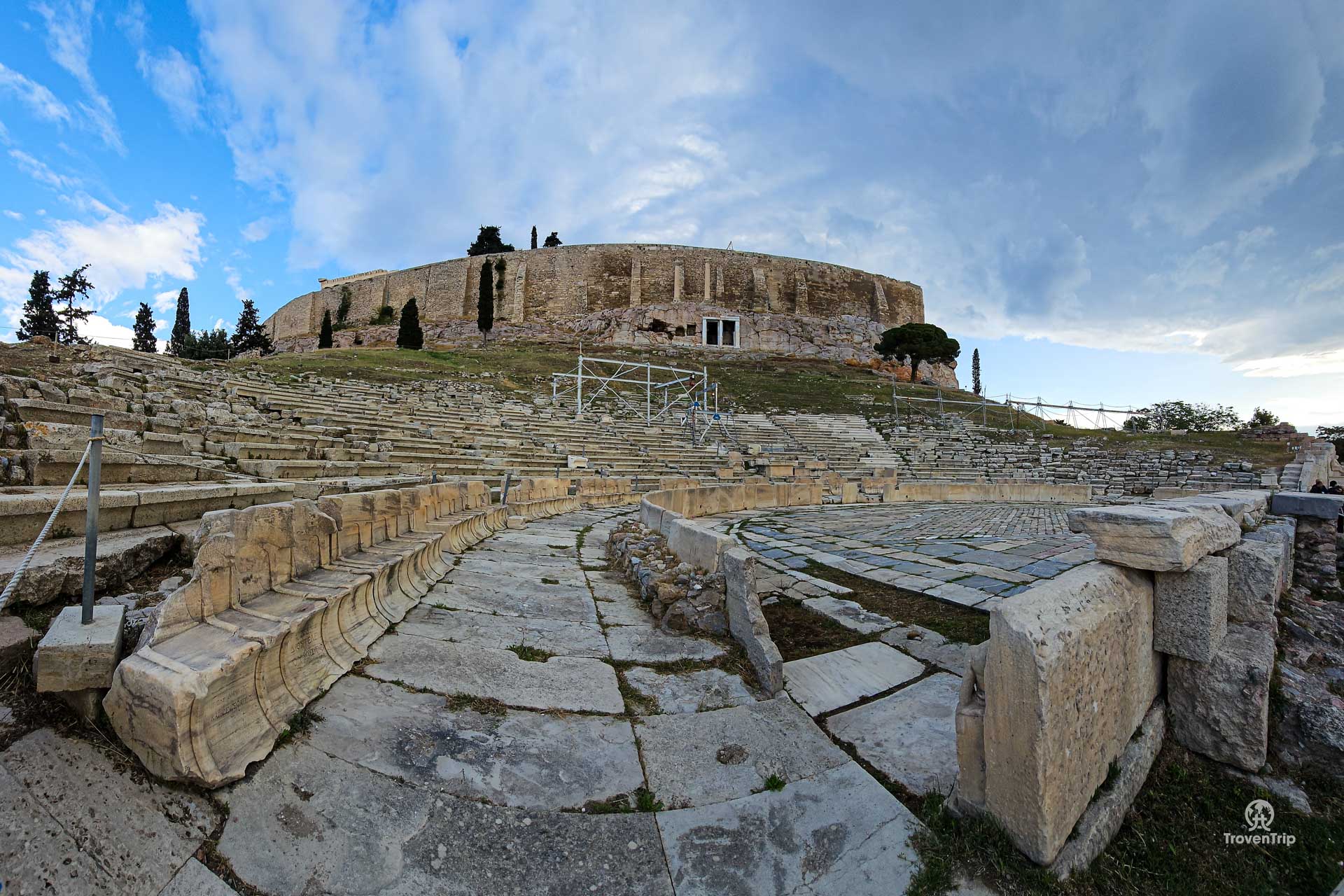 Imagine what this theatre looked like at it's peak
Imagine what this theatre looked like at it's peak  The first of many many cats we befriend on our trip!
The first of many many cats we befriend on our trip! Athens Viewpoint
We pass a couple of temples before stopping at a viewpoint with far reaching views over the city of Athens and as far as the Aegean sea.
We're told that the hills in the distance are where the very first democratic votes took place, and the vibrant colours we can see all around are the inspiration behind Greece's 3 national colours... blue to signify the sea, white to signify the marble, and green for the hills and trees.
 The viewpoint from the South Slope of the Acropolis
The viewpoint from the South Slope of the Acropolis 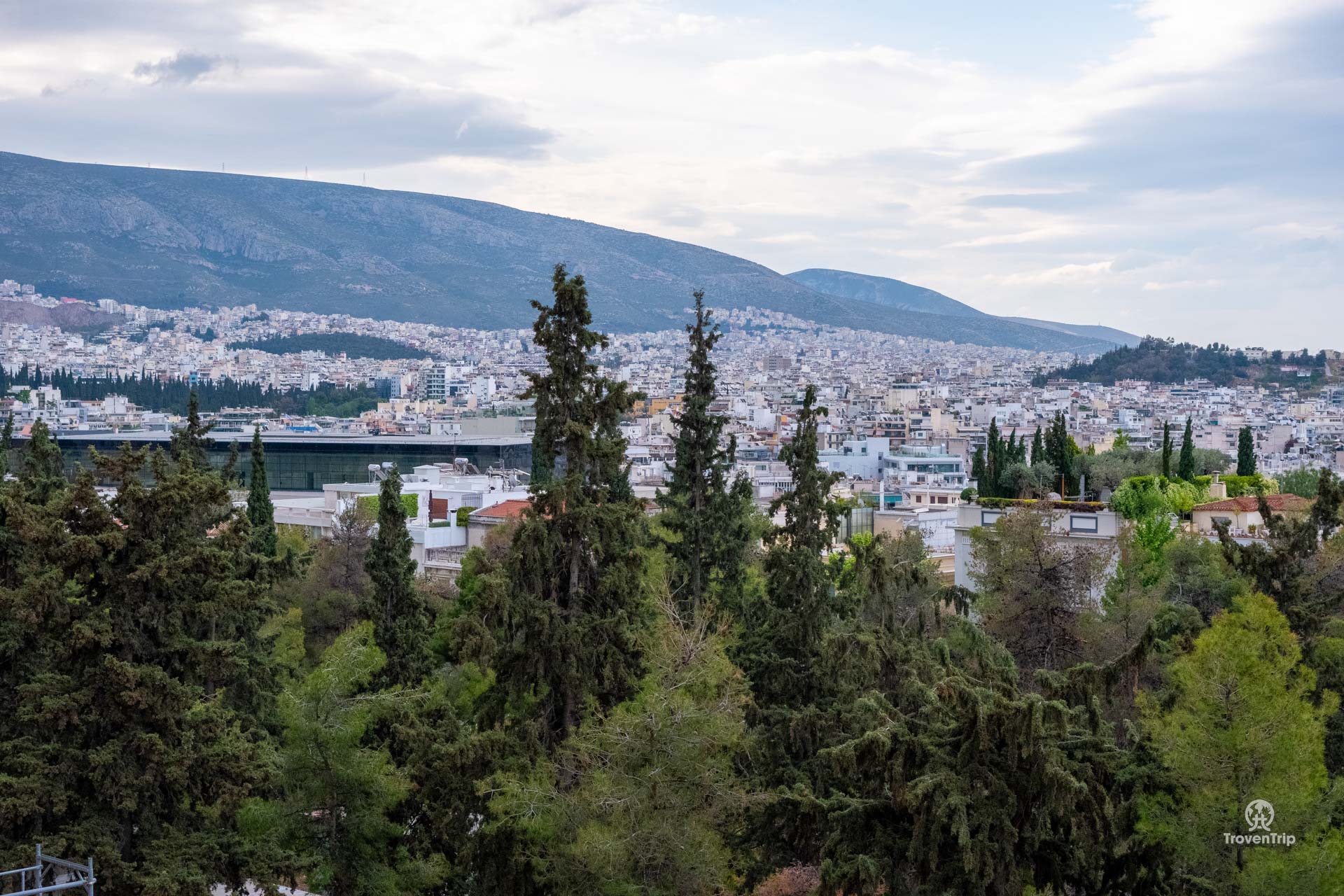 Easy to see why this was the early settlement... far reaching views to the surrounding mountains and sea
Easy to see why this was the early settlement... far reaching views to the surrounding mountains and sea  Would have been able to spot any invaders before the modern city was built
Would have been able to spot any invaders before the modern city was built Odeon of Herodes Atticus
One of the most recent structures within the Acropolis at a mere 1,800 years old is the Odeon of Herodes Atticus, the only remaining Roman building here.
Much like the older Theatre of Dionysus, this amphitheatre was a cultural centre of it's day used for plays, music performances and competitions. It's also a lot more intact than the Theatre of Dionysus (or has at least been restored), and is still used for some performances today.
Standing at the top and looking down towards the stage the theatre looks huge... but this only holds 5,000 people, so imagine how big the 17,000 capacity Theatre of Dionysus was at it's peak!
 The 5,000 seater Odeon, it still hosts performances today
The 5,000 seater Odeon, it still hosts performances today  Great views of the stage and the city beyond
Great views of the stage and the city beyond Monumental Gateway of the Acropolis
Leaving the southern slopes of the Acropolis behind we start our ascent to the top, and with the crowds starting to grow, the steep and slippery steps aren't the easiest to navigate (make sure you wear good footwear when visiting).
The short climb is more than worth it though... at the top of the steps we pass through the Monumental Gateway and see how this ancient architecture still has an influence on European design. Although this gateway is 2,500 years old, you could be forgiven for thinking you'd just walked through the 18th century Brandenburg Gate in Berlin or the Arco della Pace in Milan!
And looking closely at the architecture at the top, we're sure that's some Lego pieces we can see... (make sure to ask the guide to point it out if you can't spot it)
 The Monumental Gateway, some entrance!
The Monumental Gateway, some entrance! 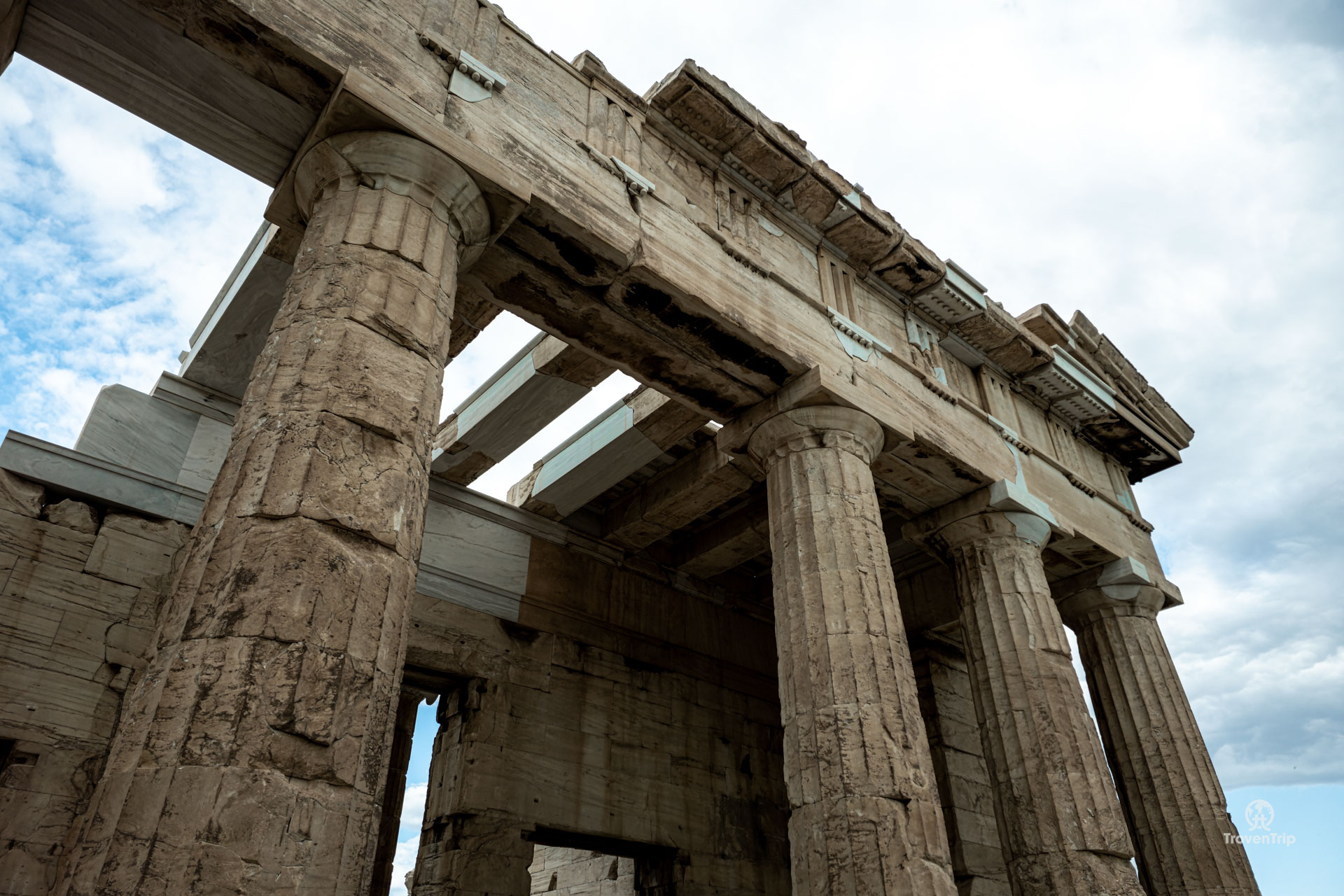 Can you see the Lego pieces?
Can you see the Lego pieces? Parthenon
If you've ever seen a photo of Athens, then you'll have seen the Parthenon!
Not the best preserved temple of the Acropolis, but it's the masterpiece. Dedicated to the goddess Athena who the city of Athens is named after, the Parthenon is the iconic temple on the site, and the must see attraction.
The Parthenon is the "expression of the free people following democracy" Sophia says, as she explains the history of the temple having been a Christian Church, a Mosque, and even a gunpowder store during times of occupation from the Persian, Ottoman and Byzantine empires.
The history is fascinating and Sofia shows us pictures of how it looked through the ages, including a 12m high statue of Athena which once stood in the entrance but was lost long ago.
After having seen so many photos of the Parthenon over the years, and seeing it lit up from a distance last night, seeing something so iconic up-close for the first time is truly majestic.
 The view of Parthenon from the fort
The view of Parthenon from the fort 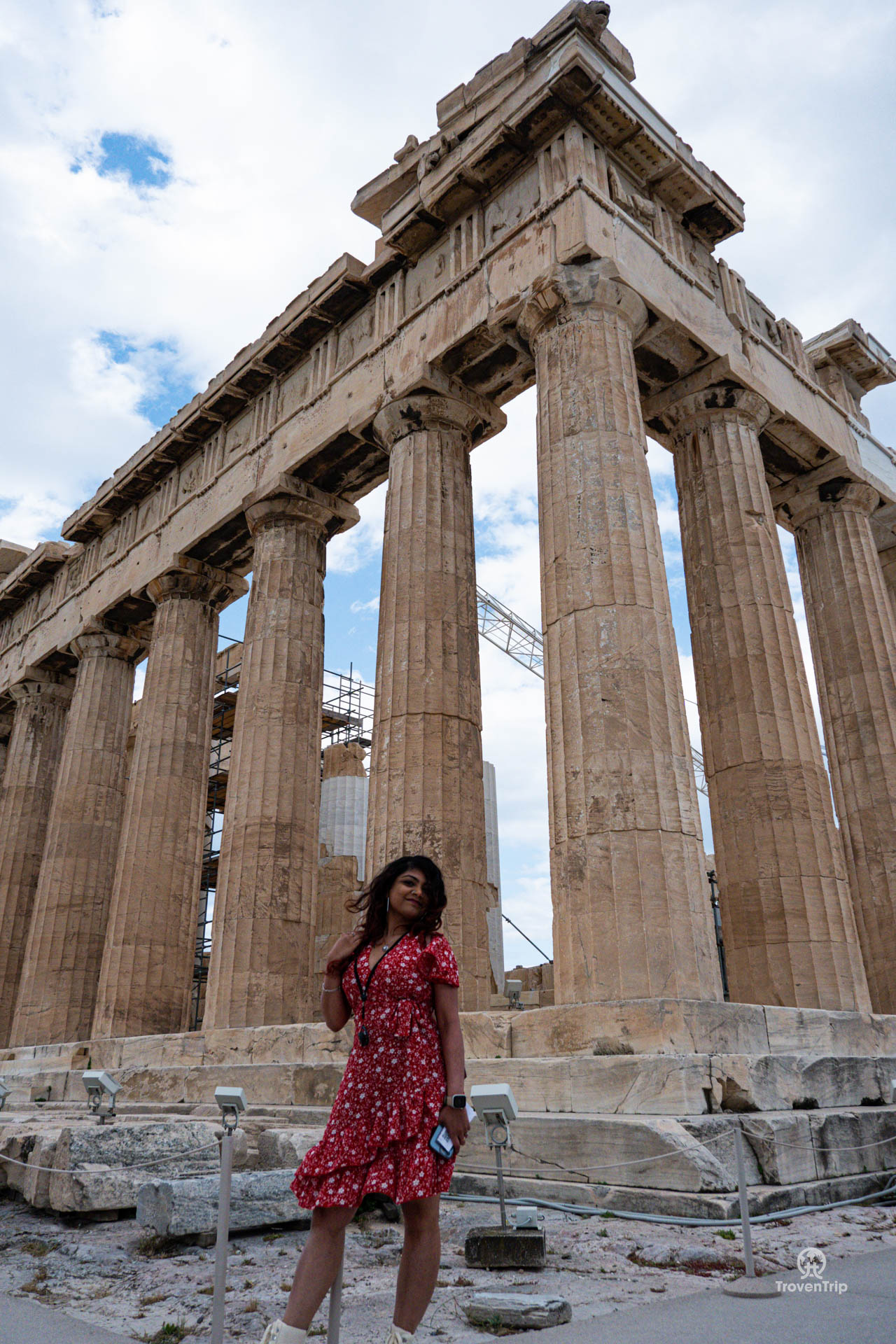 Parthenon - A good photospot
Parthenon - A good photospot 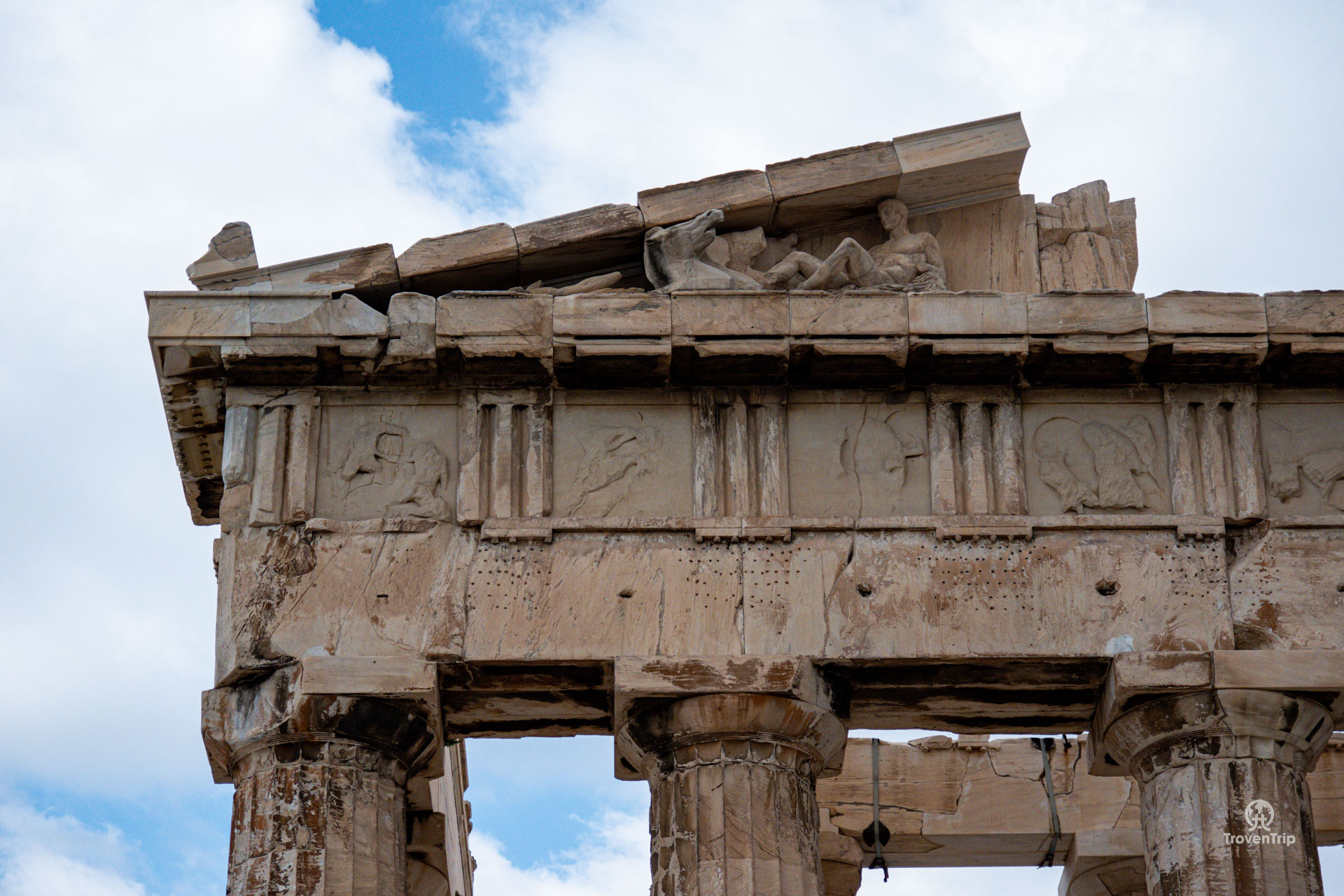 The statue on Parthenon that still stands upright
The statue on Parthenon that still stands upright 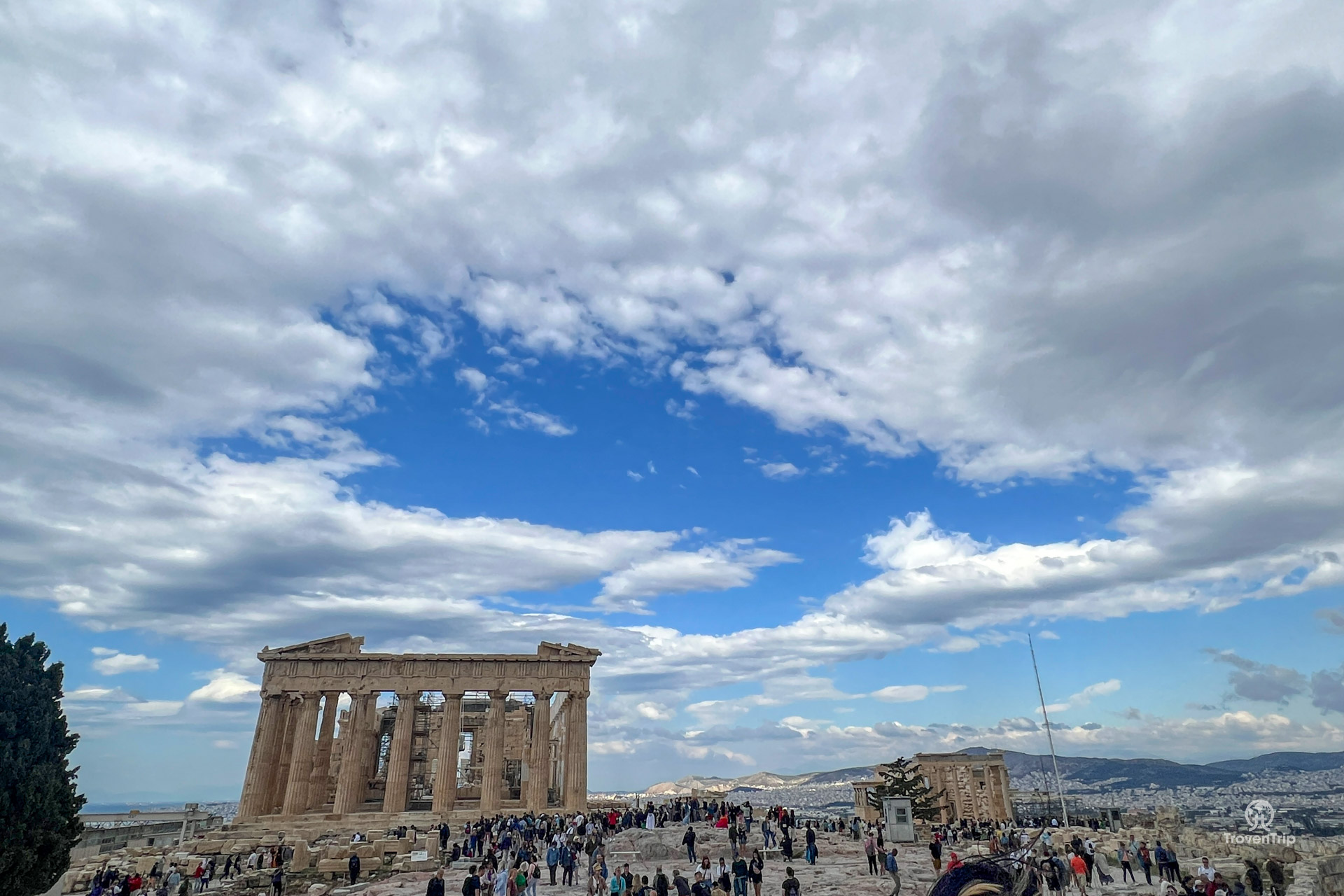 Has to put the pic as the sky looked so dramatic that Sneha was in love with the sky!
Has to put the pic as the sky looked so dramatic that Sneha was in love with the sky!  Parthenon - it is really huge!
Parthenon - it is really huge!  Parthenon - A good photospot at the back
Parthenon - A good photospot at the back We can see how the columns are not evenly spaced and are tapered from the bottom to the top, making it a unique design and all the more impressive. And even though most of the frieze and sculptures are now either housed in the Acropolis Museum or the British Museum (is there nowhere Paul can visit without feeling bad for the historic pillaging of his ancestors?? 
The tour takes a break at this point so we're free to roam around. At the far end away from the Parthenon is a small fort which gives 360° views of Athens and is a must visit to get a photo of the Parthenon in the background (there are also toilets here, and drinking fountains to fill up water bottles).
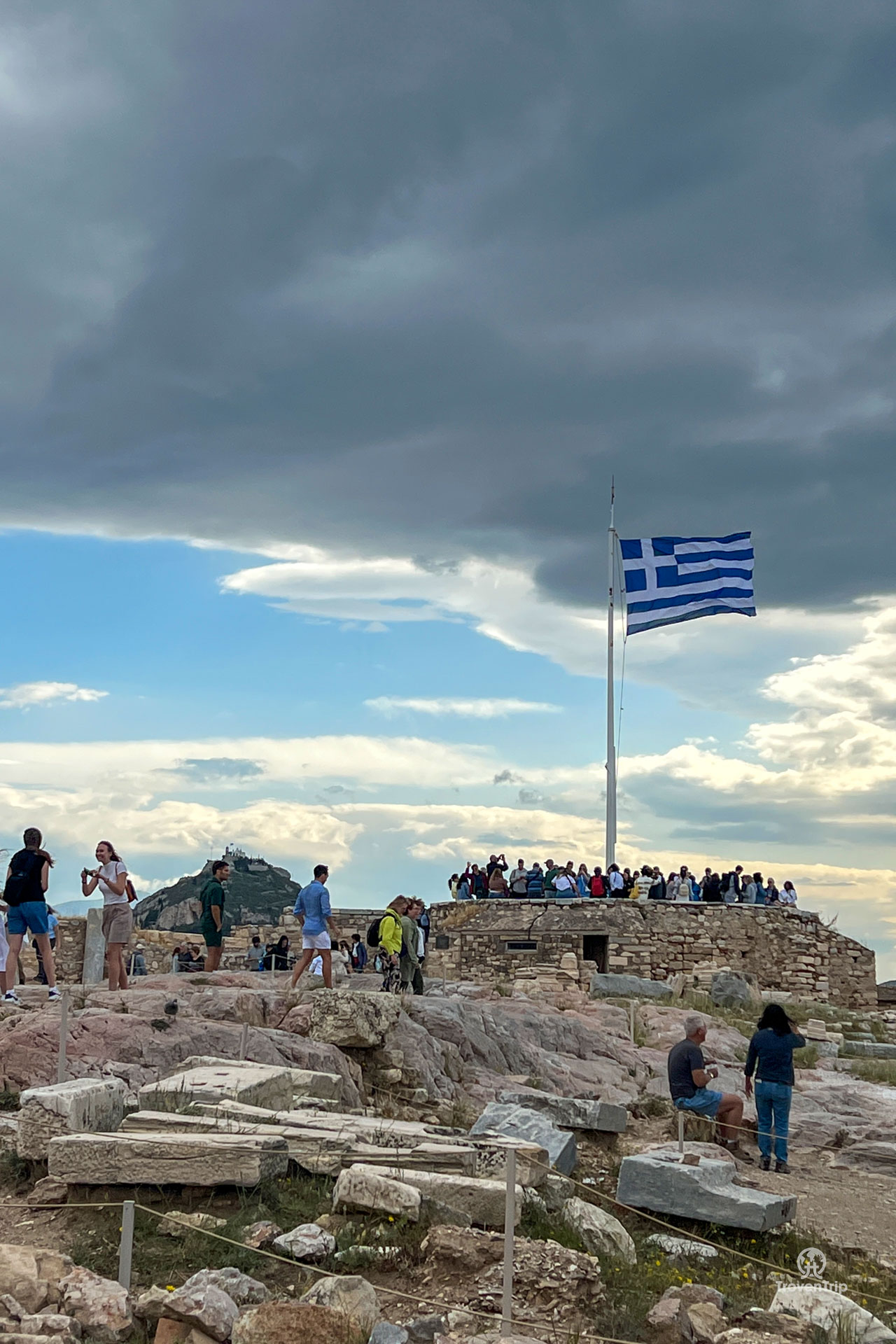 Parthenon - View from the fort
Parthenon - View from the fort  Check out Temple of Hephaestus and the Greek Agora from the Acropolis
Check out Temple of Hephaestus and the Greek Agora from the Acropolis  Views over the city and to the hills beyond
Views over the city and to the hills beyond 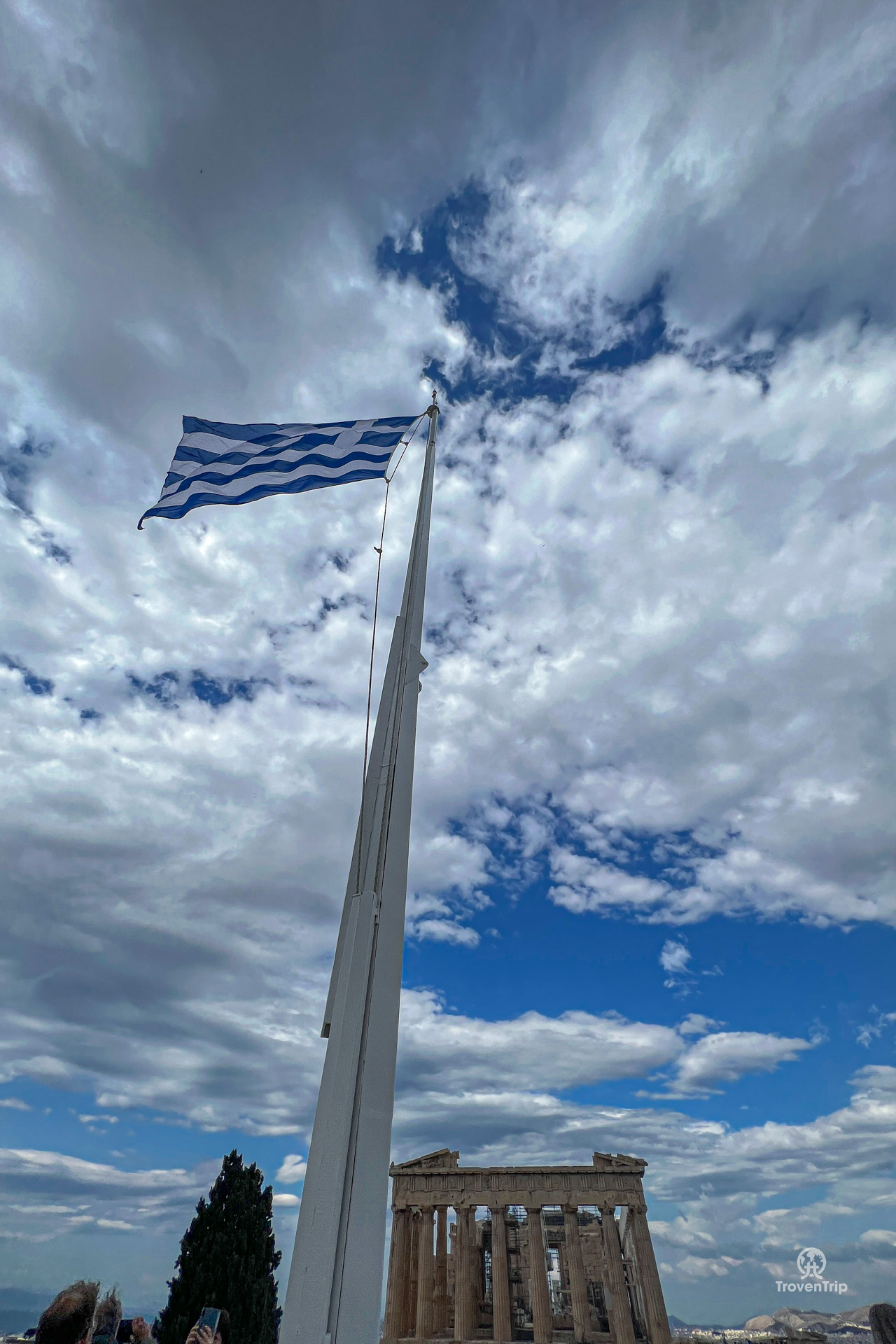 Flag of Greece fluttering proudly in front of the Parthenon
Flag of Greece fluttering proudly in front of the Parthenon Temples of Erechtheum & Athena Nike
While the Parthenon may be the masterpiece of the Acropolis, the most sacred temple is Erechtheum, dedicated to the gods and goddess Athena, Poseidon, and Erechtheus.
This smaller temple is unique in having the Porch of the Caryatids... 6 elaborate angel statues holding up the entablature. The Caryatids in place today are all replicas, with the originals on display in the Museum which we'll get to see later (well 5 are, the 6th is again in the British Museum 
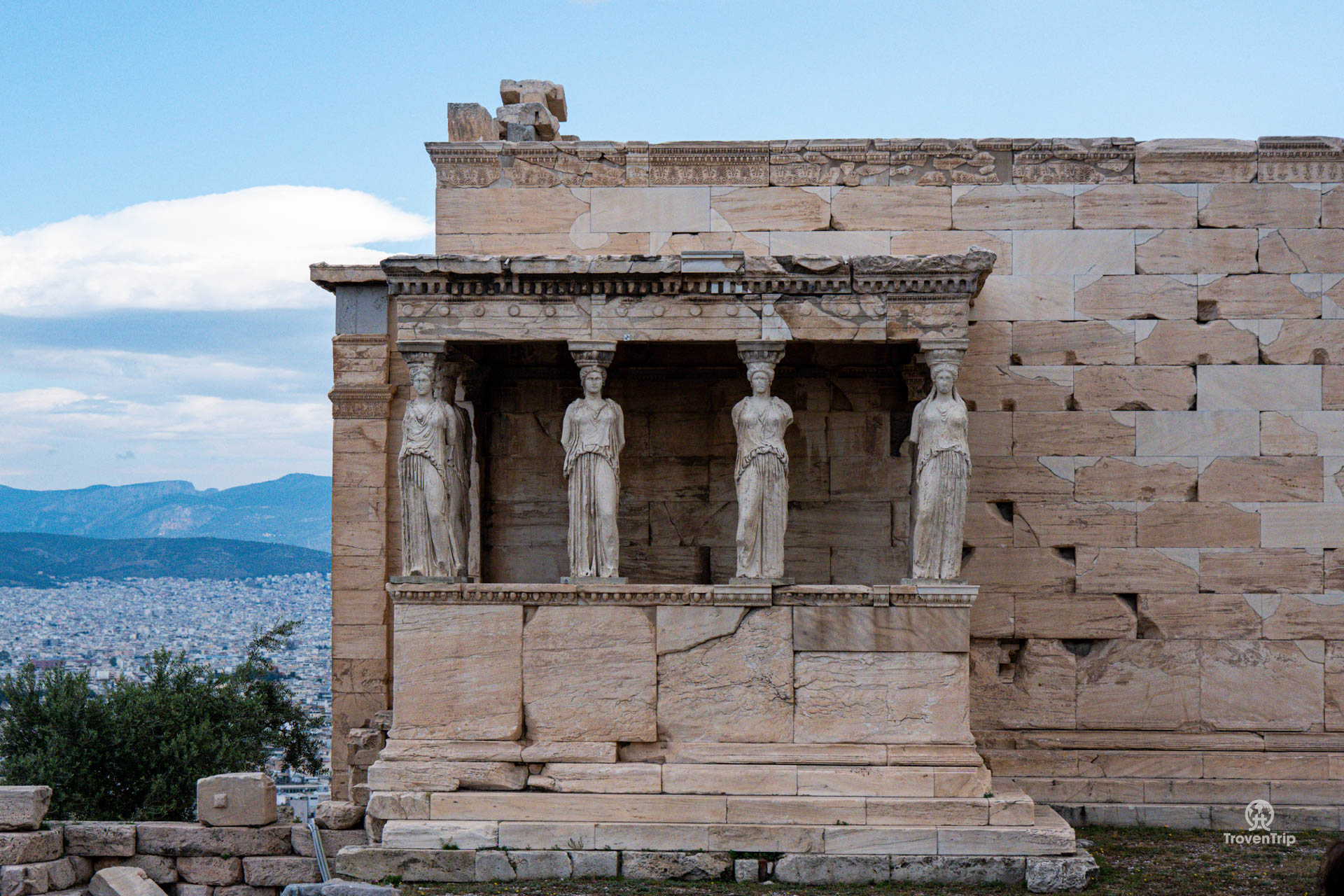 The Caryatids (or replicas of) in place on the Temple of Erechtheum
The Caryatids (or replicas of) in place on the Temple of Erechtheum  Dramatic setting at the edge of the Acropolis
Dramatic setting at the edge of the Acropolis  Side on view of the Caryatids
Side on view of the Caryatids  Another good photospot
Another good photospot The last temple we see as we leave through the Monumental Gateway to head back down is the Temple of Athena Nike. The smallest temple on the Acropolis, it is positioned at the edge to overlook the Greek Agora and entrance to the city. Symbolising the military victories and serving as a reminder of the city's power and prestige, Sofia also points at Paul's Nike trainers and explains why the sportswear company is named after the ancient goddess of victory!
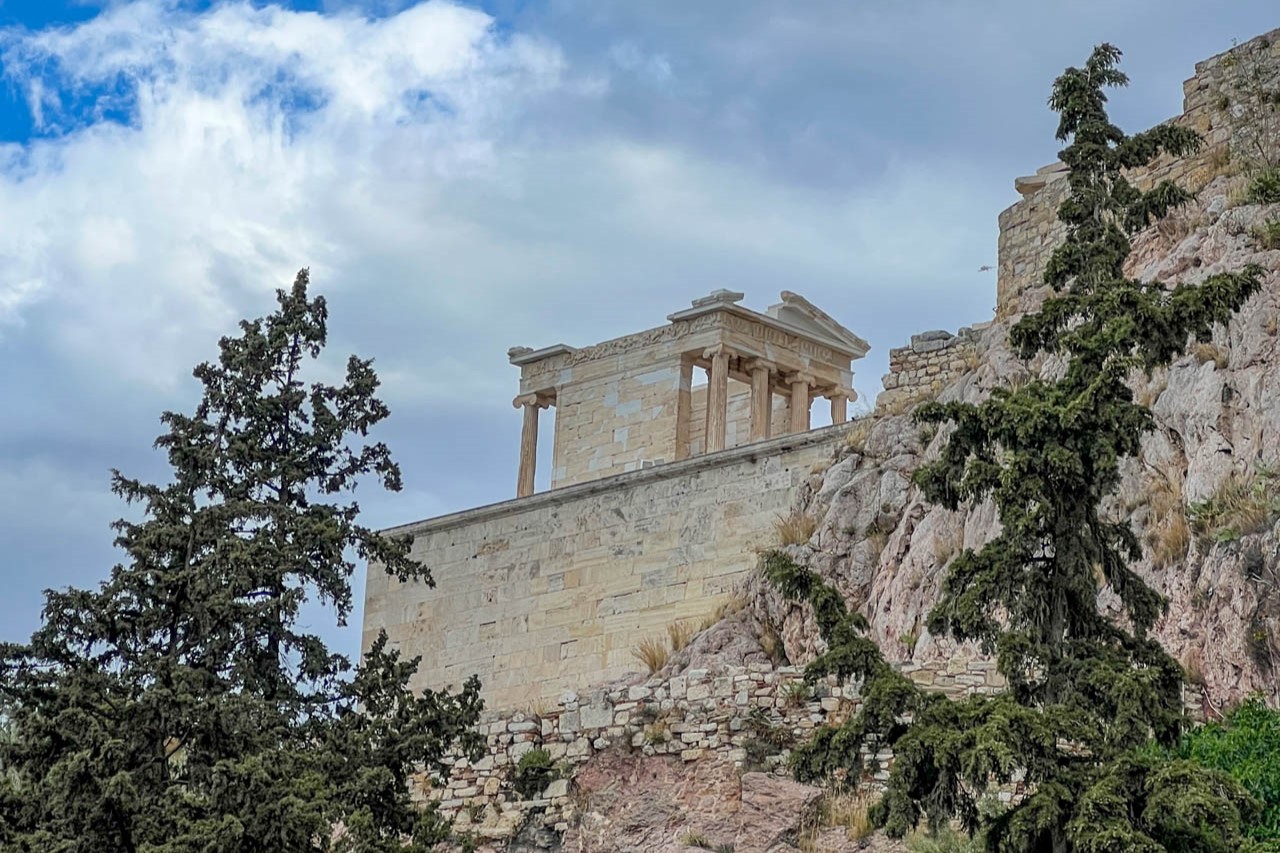 The Temple of Nike, perched on the edge
The Temple of Nike, perched on the edge 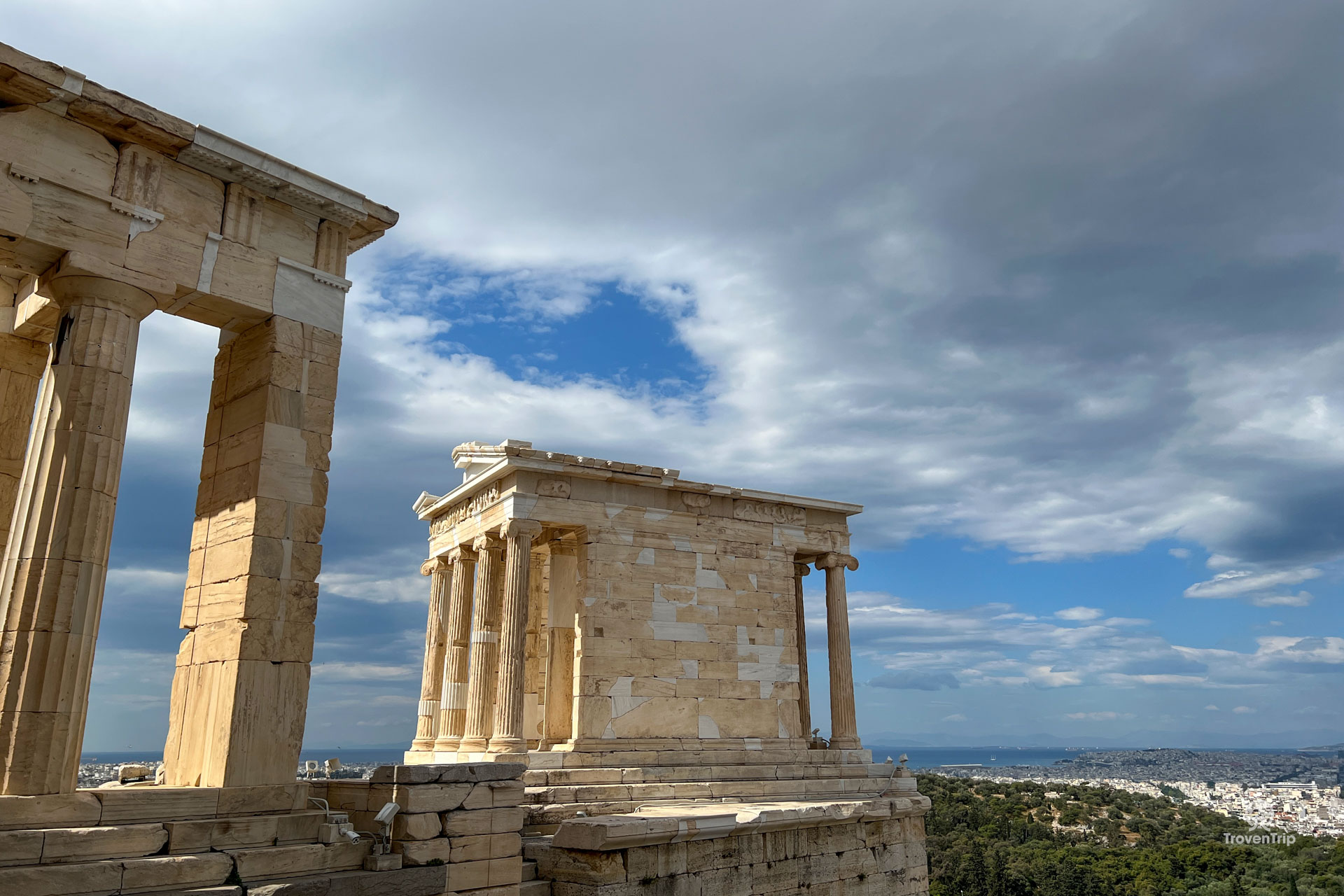 The smallest of the temples on the Acropolis but an important one
The smallest of the temples on the Acropolis but an important one Ancient Greek Agora of Athens
Outside of the Acropolis, the most important place in ancient Athens was the Greek Agora.
The heart of Athenian society, this is where the people of the city came to socialise, shop at the markets, and discuss politics and philosophy with Socrates, Plato and Aristotle amongst others.
Today there isn't much left to see other than ruins... being the heart of Athens, this was the first place to be attacked during invasions as a way to destroy and take control of the city.
But being able to explore the ruins, walk along the ancient pathways, and gain a glimpse into the daily life and activities of ancient Athenians is a captivating experience.
Amongst the ruins, we visit the Altar of Zeus, see a statue of Triton (a mythical creature of half man half fish), but one of the coolest is the Monument of the Eponymous Heroes... here wooden boards were hung for each of the 10 Athenian tribes showing updates and news from each... the very first newspapers or blogs!
 Great views of the Acropolis
Great views of the Acropolis  The original newspapers and blogs!
The original newspapers and blogs!  Sign explaining the Monument of the Eponymous Heroes
Sign explaining the Monument of the Eponymous Heroes  The Statue of Triton
The Statue of Triton  The Altar of Zeus
The Altar of Zeus Stoa of Attalos & Temple of Hephaestus at the Agora
The two most notable structures standing in the Agora are the Stoa of Attalos, a reconstructed two-story colonnaded building that housed shops on the ground floor and public meeting spaces on the upper floor. Today it houses a museum of the Agora.
And the other is the Temple of Hephaestus which is one of the best preserved temples in Athens.
Both have very interesting architecture in their own way and make for good photo stops.
 The most intact temple in Athens, like a mini Parthenon!
The most intact temple in Athens, like a mini Parthenon! 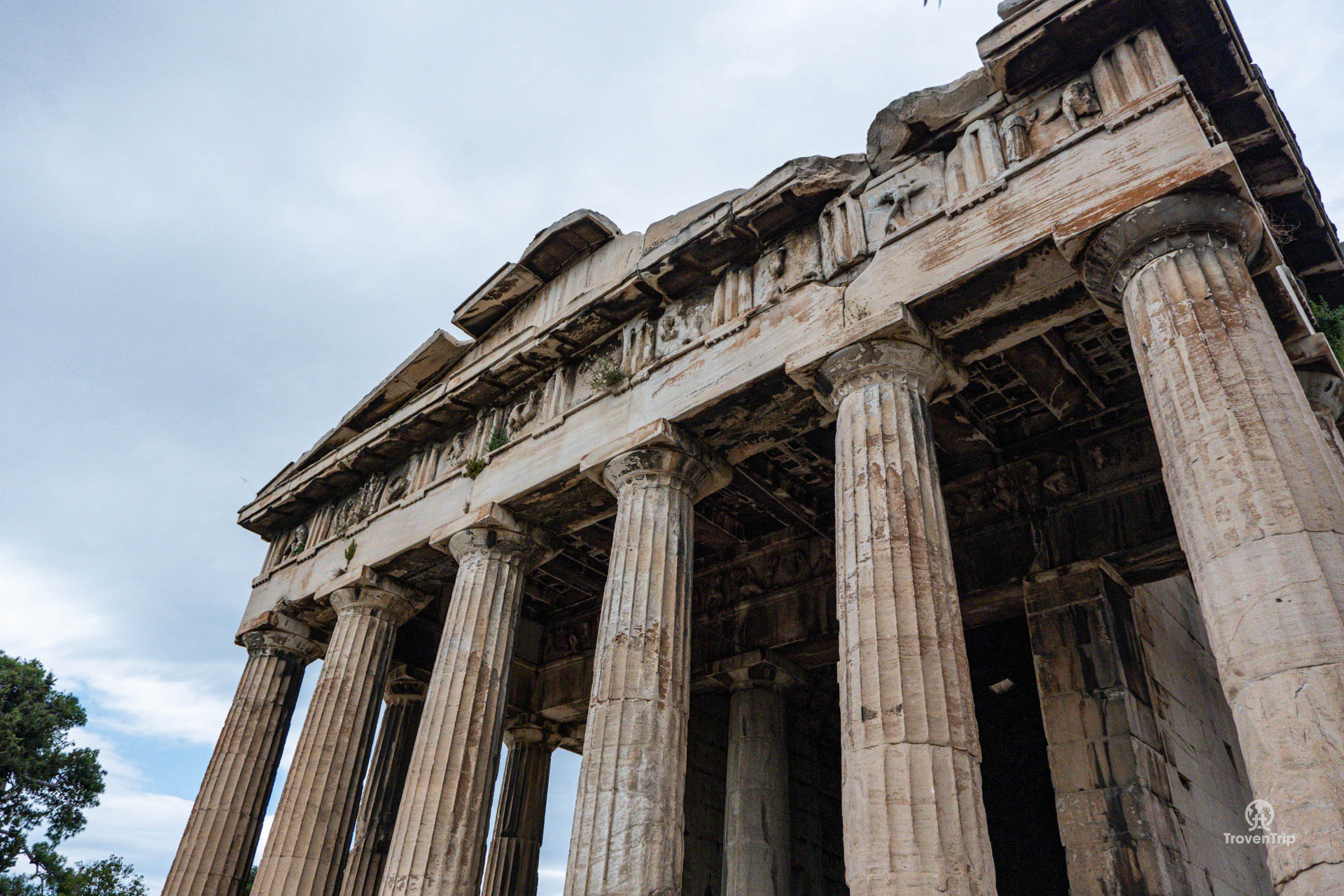 Not as intricate as the Parthenon though
Not as intricate as the Parthenon though 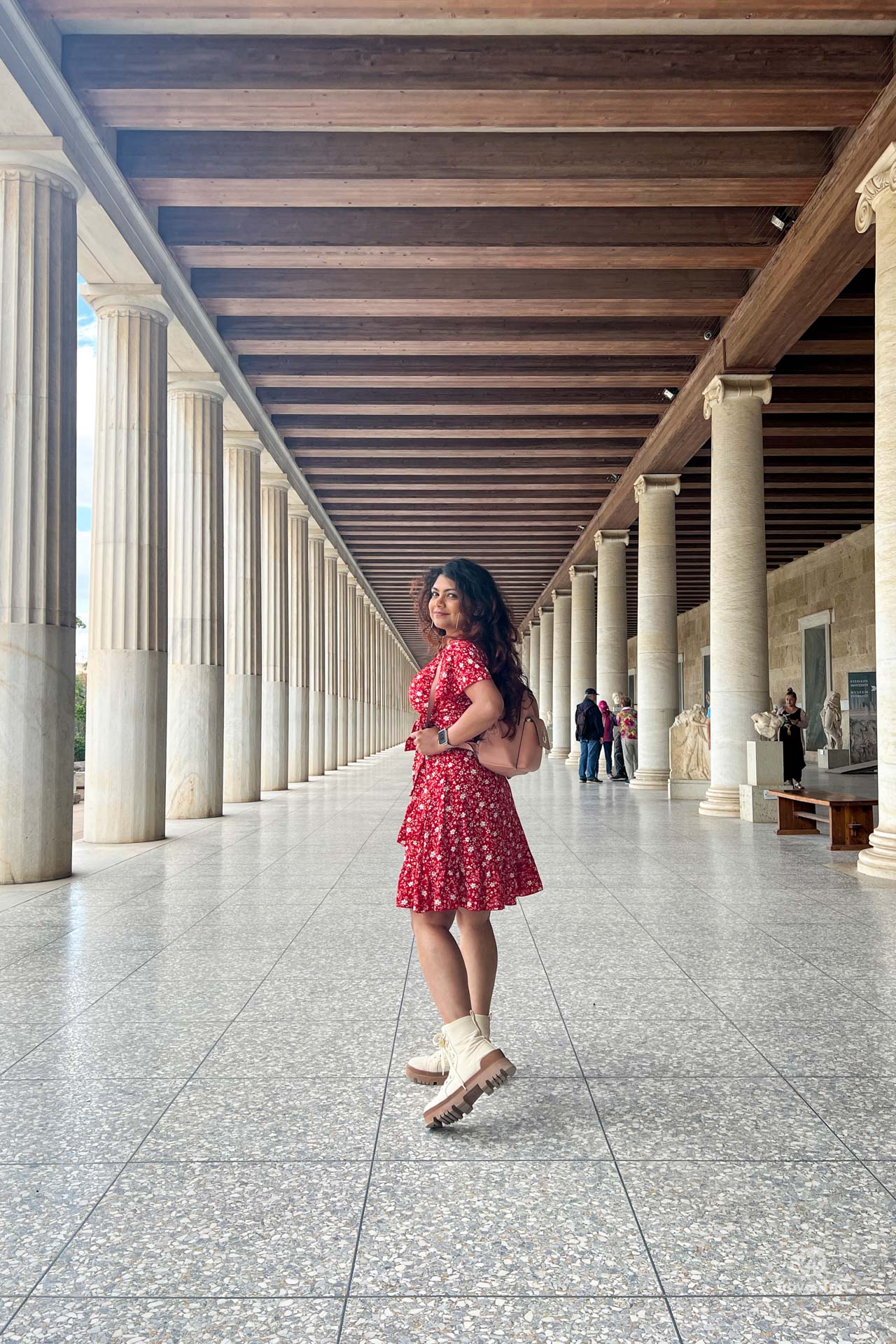 Posing in the colonnades
Posing in the colonnades 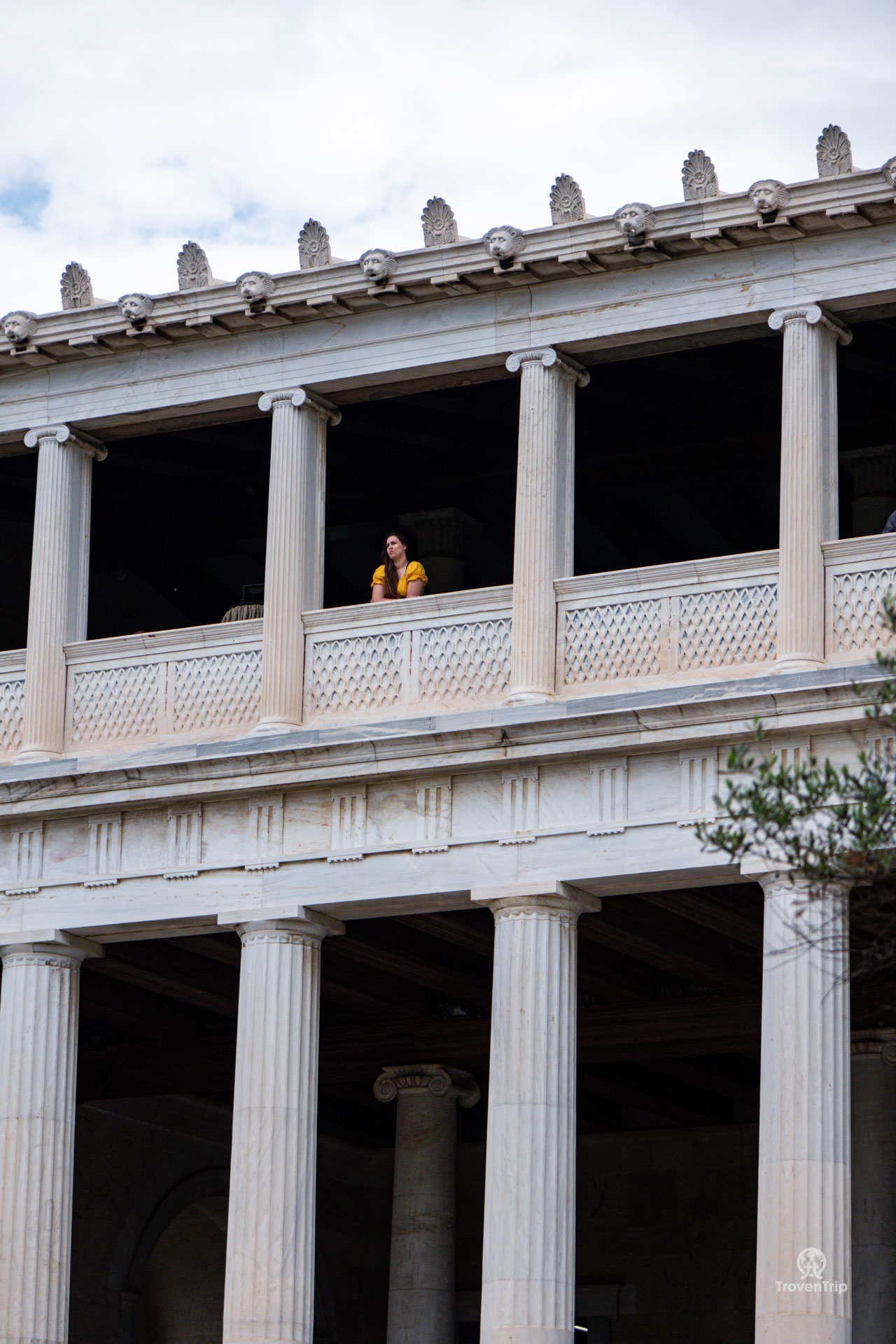 Pondering life on the balcony...
Pondering life on the balcony...  Looking into the Agora from the street in Plaka
Looking into the Agora from the street in Plaka  Close up of the colonnades
Close up of the colonnades  The Temple of Hephaestus from below in the Agora
The Temple of Hephaestus from below in the Agora Roman Agora, Tower of the Winds & Gate of Athena Archegetis
A few minutes walk away from the Ancient Greek Agora is the slightly more recent and much smaller Roman Agora.
Built by the Romans following their conquest of Athens to replace the Greek Agora, this open space became the new hub of activity in the city, although was largely used as a market.
At the far end of the Agora is the Tower of the Winds... a marble clock and weather vane which became the first meteorological station of the antiquity.
We don't go inside the Roman Agora to see the ruins or the Tower of the Winds, but we can see them to take some photos from the road as we walk around the edge on to our next location (and we get some night shots later on too).
The Walks ticket does include entry to this site, we just don't have time to fit it in on today's tour. The ticket is valid for 4 days though so if you have longer in Athens you can visit this in your own time.
 The Tower of the Winds at night in front of the Acropolis
The Tower of the Winds at night in front of the Acropolis 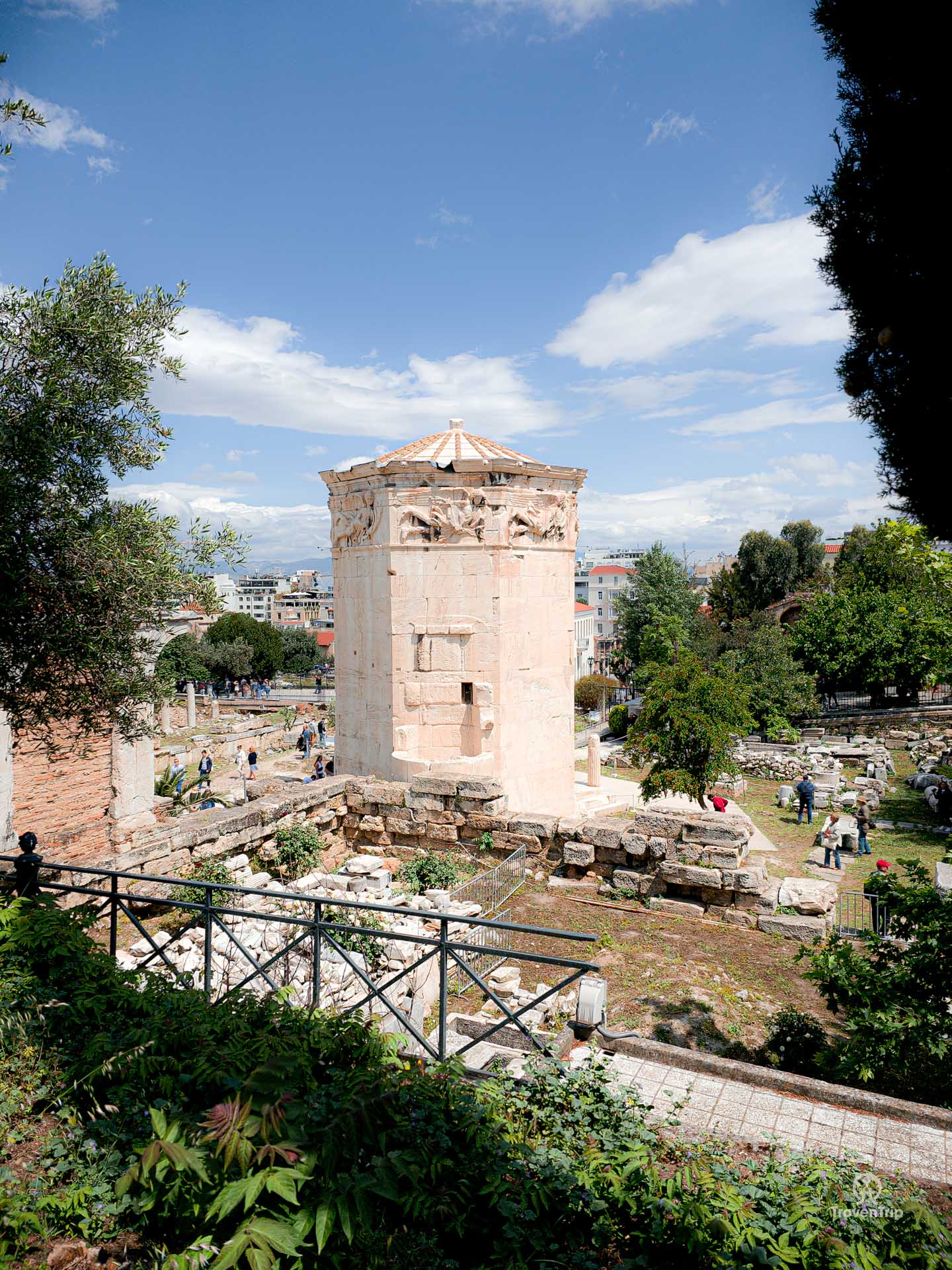 The Tower of the Winds
The Tower of the Winds 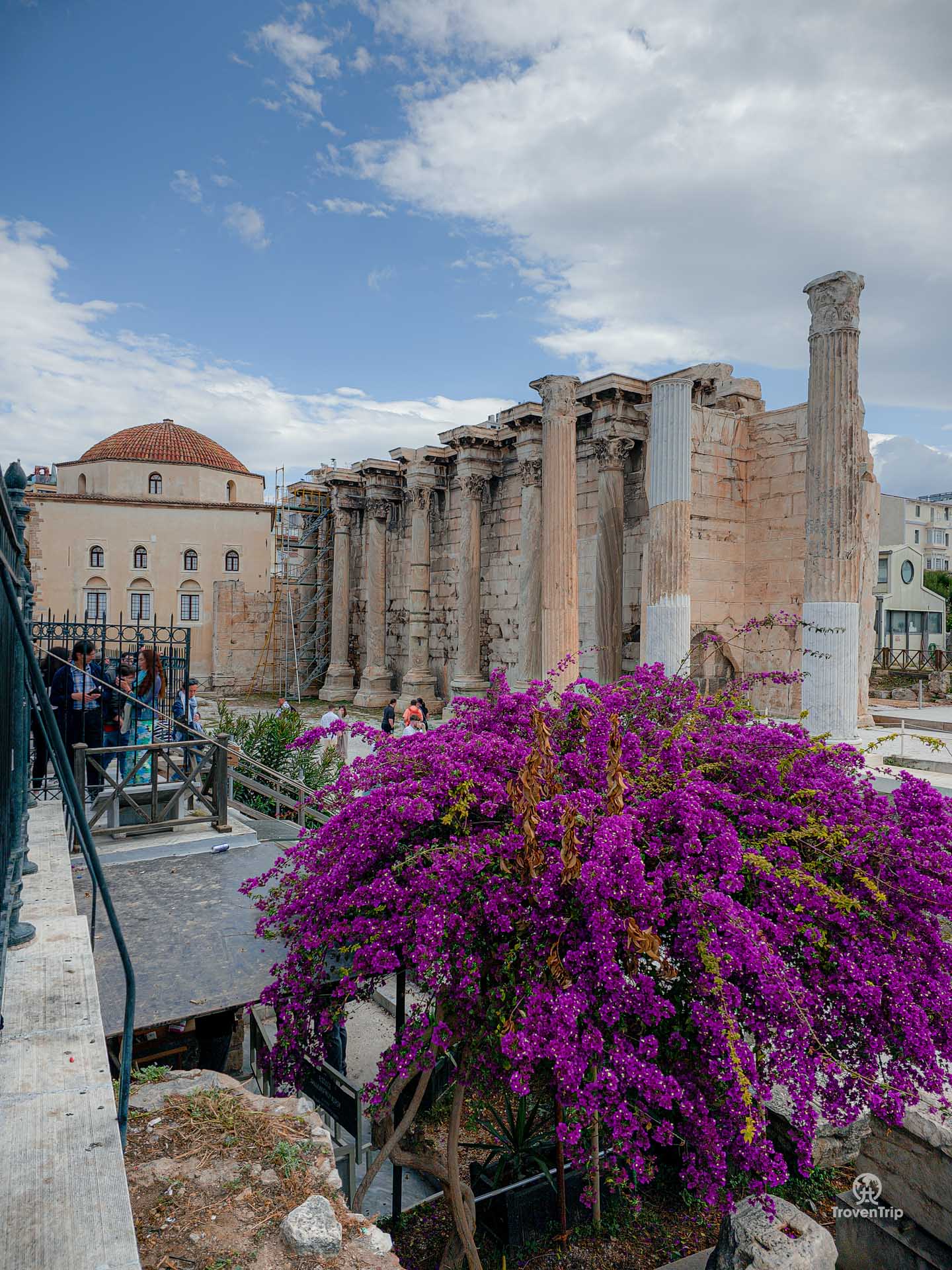 Beautiful flowers at the entrance to the Roman Agora
Beautiful flowers at the entrance to the Roman Agora 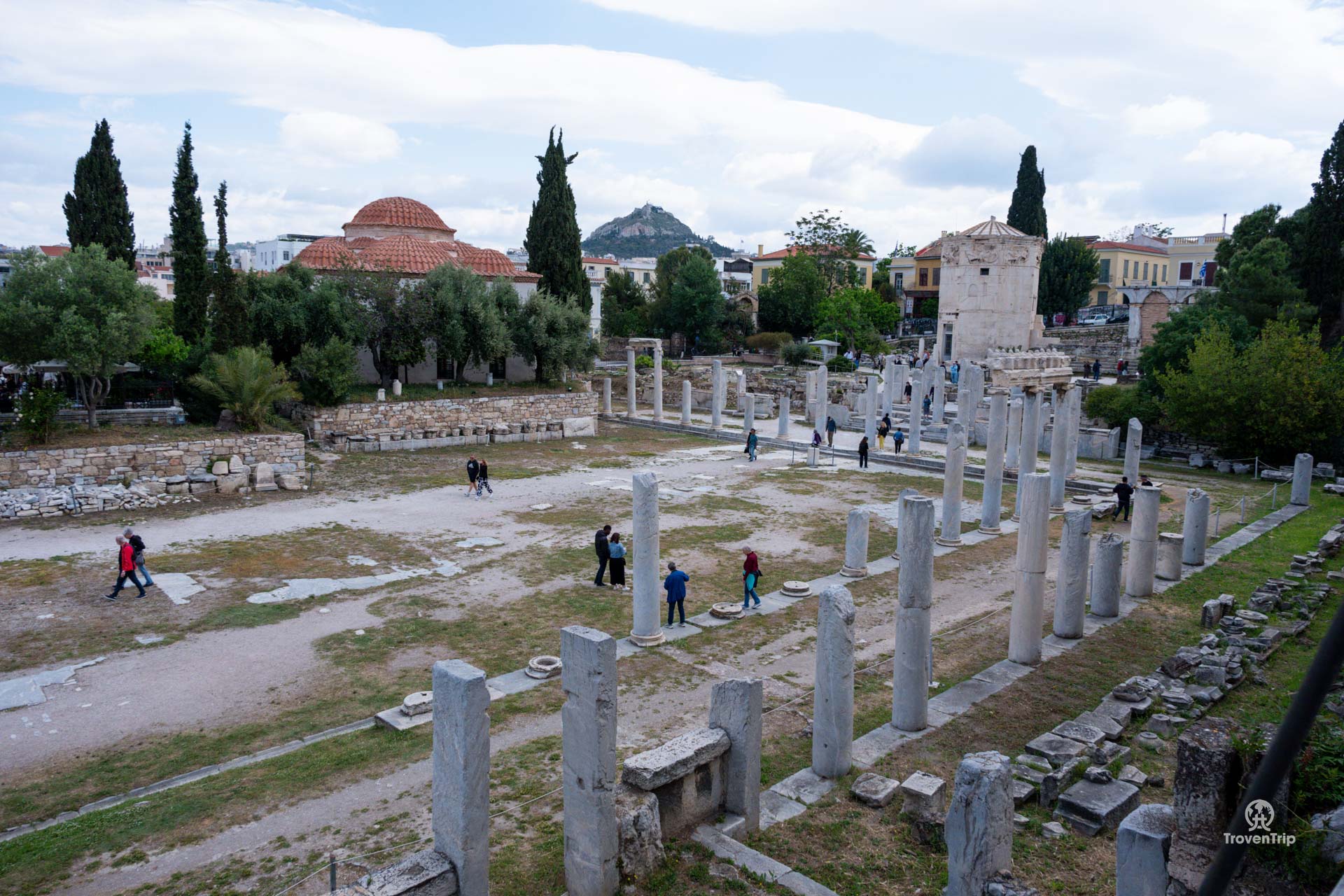 The Roman Agora is much smaller than the Greek Agora
The Roman Agora is much smaller than the Greek Agora Lunch in Plaka Old Town
As the morning draws to an end we head back towards the Acropolis and walk through Plaka, the Old Town of Athens.
The neighbourhood is a like a small village in itself. As we wander the narrow and twisting streets, we window shop in the many souvenir and boutique shops, eye up the delicious looking lunches being served in the many cafés and restaurants, and make a mental note of which we want to return to later.
Just as the smell of the food is becoming too tempting not to stop, Sofia says it's lunchtime (hooray!) and we can meet back next to the New Acropolis Museum in 1 hour, giving us plenty of time for lunch and some souvenir shopping.
All of the cafés look great, and we opt for Spezie Café, ordering Gigas (a breaded version of Gyros), and some interesting Greek cocktails... a Spezie and an Acropolis. Sneha loves them but the Ouzo taste isn't quite to Paul's liking!
 Paul thought the food was better than the cocktails, although Sneha loved the Ouzo!
Paul thought the food was better than the cocktails, although Sneha loved the Ouzo!  The most famous street in Plaka, Erechtheos
The most famous street in Plaka, Erechtheos  Even the residents look ancient!
Even the residents look ancient!  Another pretty street in Plaka
Another pretty street in Plaka New Acropolis Museum
After having experienced the temples and ruins at the Acropolis this morning, after lunch we head into the New Acropolis Museum... a state of the art museum housing some of the original archaeological treasures and sculptures from the Acropolis site.
In contrast to the ancient remains and artefacts on show at the museum, the museum itself a very modern building (built cleverly on supports to show the foundations underneath), with large glass windows to allow the natural light to flood in and display the exhibits as they would have looked in the sunshine on top of the Acropolis.
As we walk to the entrance Sneha stops and shouts "look at all of the tortoises!" We all stop and look, and on the grass in-front of the museum there are lots of them, grazing on the grass and bathing in the sun! "That's a good way to keep the grass mown and tidy" someone else comments!
Again we have skip the line tickets so we can go straight in, and having a guided tour in here is really helpful to find our way around, learn the interesting facts and stories behind the relics, and find out what it is we're looking at. There aren't a lot of information signs and so some of the tourists we see look a bit lost wandering aimlessly around the museum.
We start on the third floor gallery which is wholly dedicated to the Parthenon, with the room dimensions built to match those of the Parthenon to display the artifacts recovered from the site.
 Figures of the Greek Gods from the Parthenon decorations
Figures of the Greek Gods from the Parthenon decorations 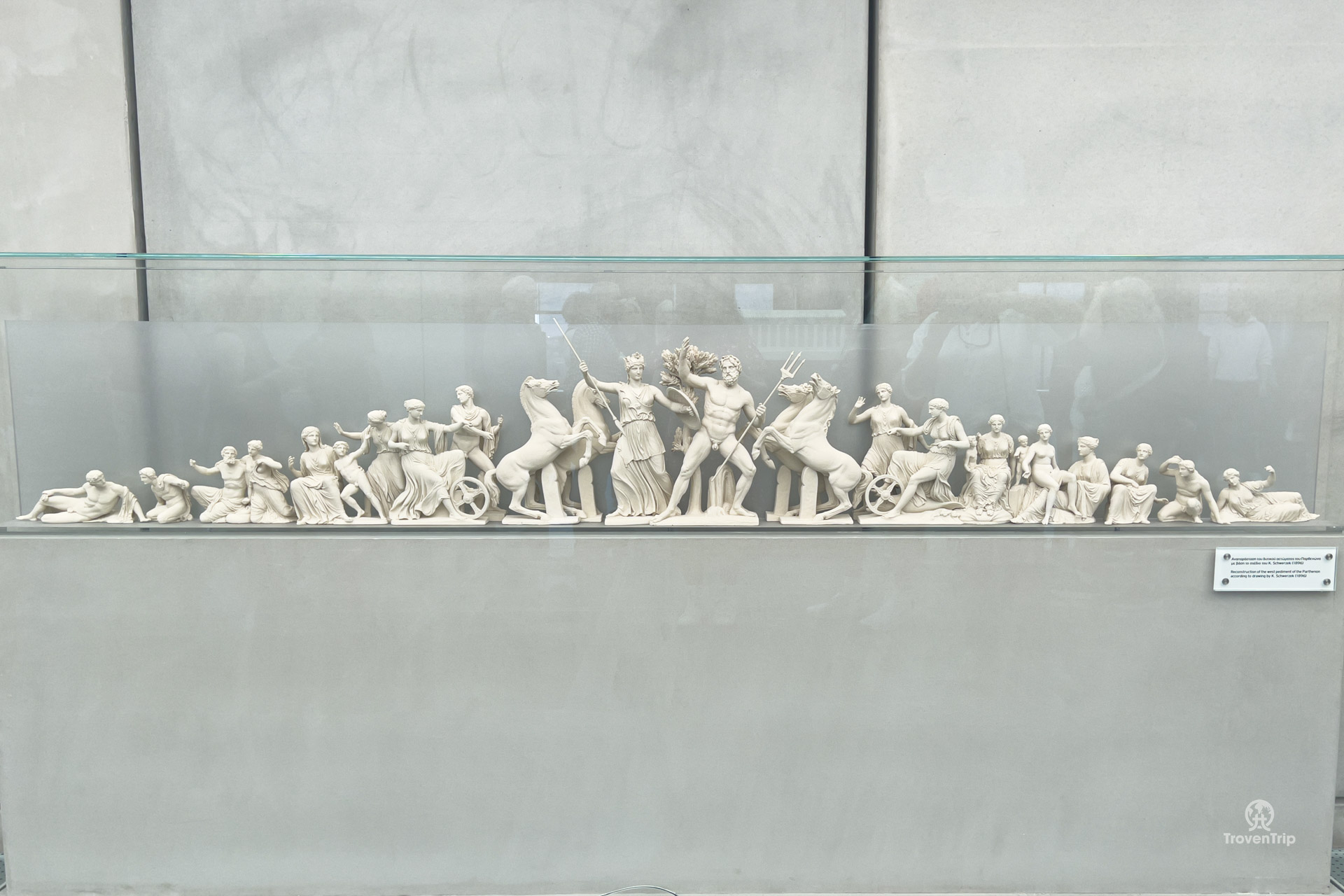 More figures of the decorations
More figures of the decorations  One of the many tortoises keeping the lawn short!
One of the many tortoises keeping the lawn short!  Entrance to the museum
Entrance to the museum  A model of the full Parthenon
A model of the full Parthenon Parthenon Marbles
All around the gallery are the Parthenon Marbles (or those which reside in the museum anyway, again, more can be found in the British Museum 
Some of the marbles are original, some have been carefully restored, and some are complete replicas of those either completely destroyed or not on show here. Sofia helps us identify which is which by looking at each stone.
Each of the Marbles is unique and tells it's own story... Sneha is mesmerized by this, her favourite being the procession of Goddess Athena, rows of men riding horses, politicians, working men, priests and priestesses, and at the end, a young boy offering a dress to the priest to present to Athena as other Gods hold court in the chamber... don't miss this!
We find it hard to comprehend how this intricate detail was created in huge marble slabs, and then hoisted up and positioned on the Parthenon, thousands of years ago without any of today's machinery or technology... seriously impressive!
 The Marbles telling the stories of the day
The Marbles telling the stories of the day  It's impressive how they've designed the gallery to replicate the positioning on the Parthenon
It's impressive how they've designed the gallery to replicate the positioning on the Parthenon  Close up of one of the marbles
Close up of one of the marbles  Sneha;s favourite...
Sneha;s favourite...  Some of the original 2,500 year old marbles
Some of the original 2,500 year old marbles Caryatids of the Acropolis & Archaic Acropolis Gallery
Down on the lower galleries are more artifacts from the Acropolis, our favourites being the original Caryatids from the Erechtheum, and the Archaic Acropolis Gallery.
As with the Marbles, seeing the Caryatids up-close and examining the detail of each makes us wonder how they were carved so intricately and accurately, they are beautiful and each one unique.
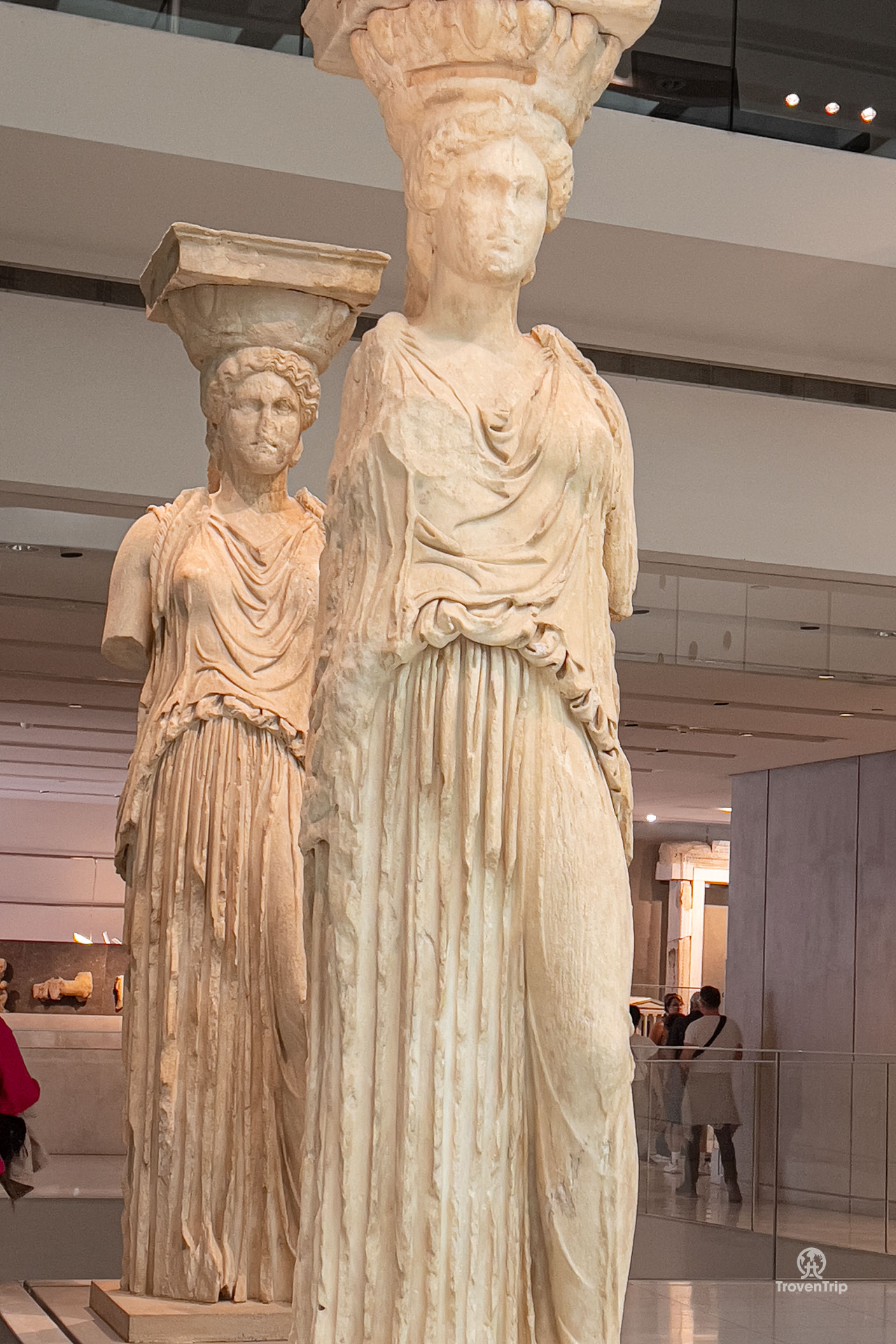 The beauty of women in Greek mythology
The beauty of women in Greek mythology 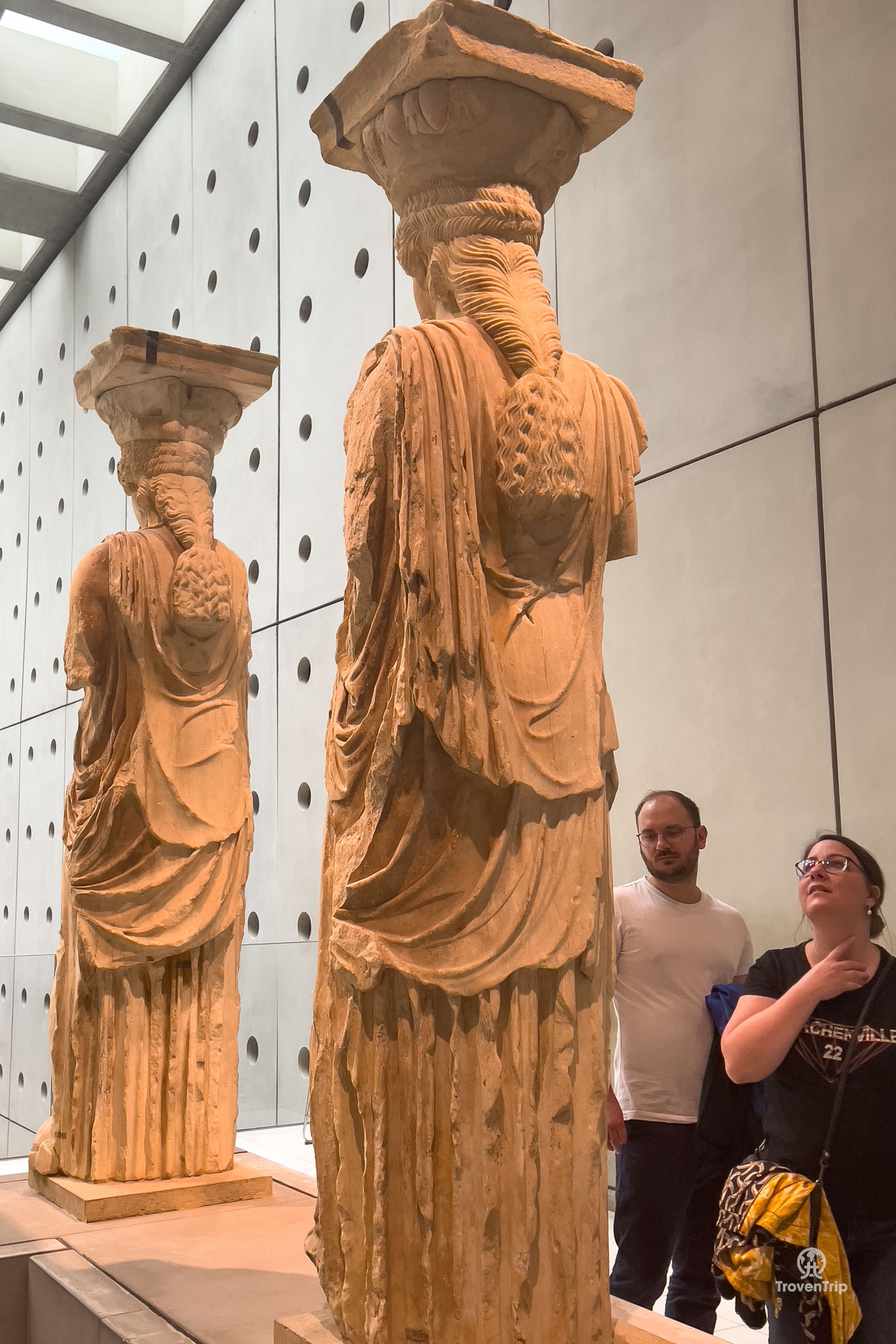 So much detail with the hair too
So much detail with the hair too 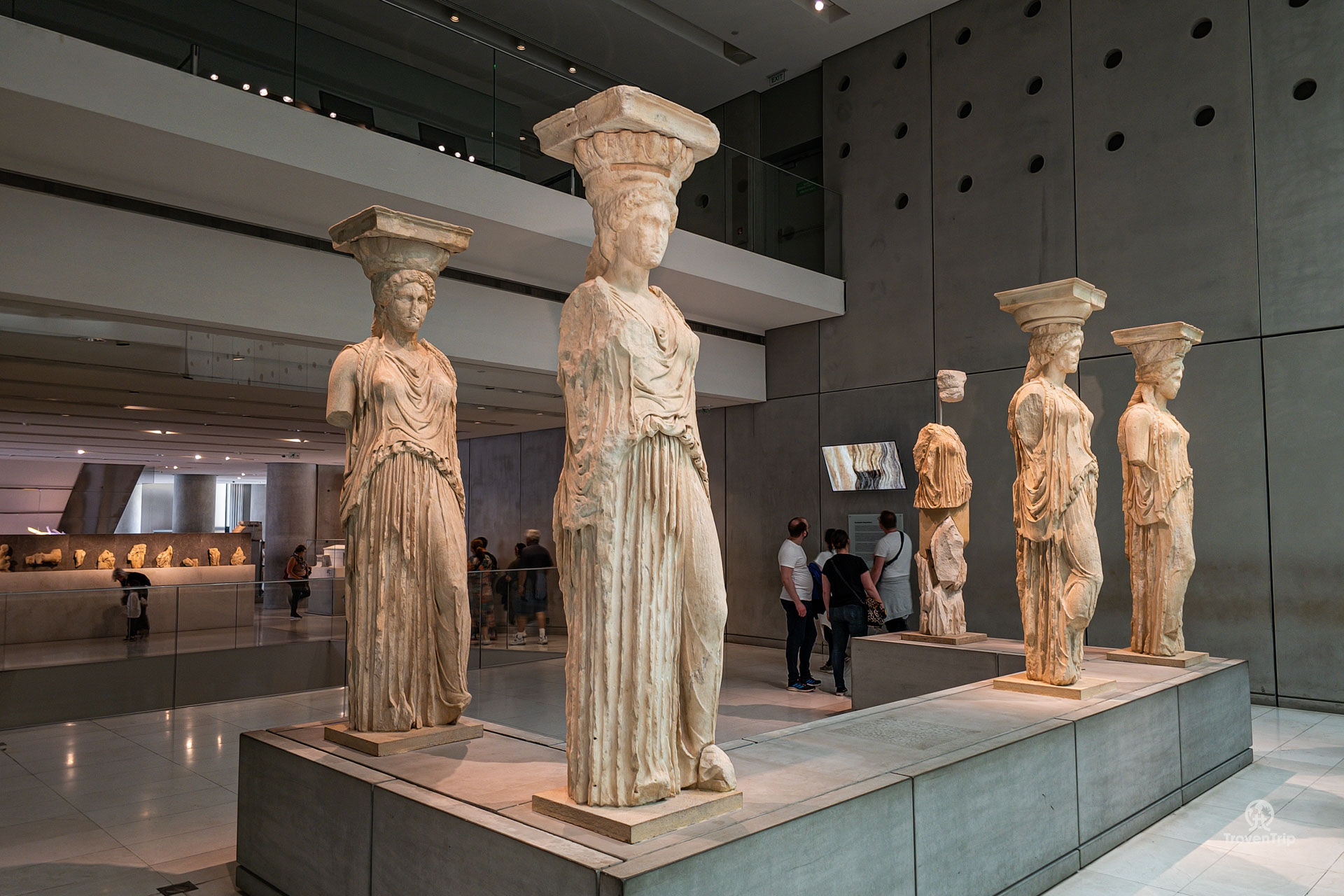 One is missing, Paul wonders where she could be?
One is missing, Paul wonders where she could be? The Archaic Acropolis Gallery is where some of the most sacred dedications are housed, so much so photos and videos are not allowed in this part of the museum. The interesting fact of this gallery is that although the statues seem to be randomly placed all around the room, they are actually perfectly positioned in the same place in which they were found and excavated on the Acropolis.
And another interesting aspect is a digital screen next to one of the statues showing how it may have looked originally... seeing all of the white marble dedications as they are today, it's easy to think that's how they would have looked thousands of years ago. But they were actually full of colour... bright and vibrant, dedications made by the people of the time to show off their wealth and social standing. The beautiful and famous girls of the time dressed to impress, and some of the designers of today could take inspiration from some of the simplistic but elegant designs.
Some photos can be seen on the New Acropolis Museum Website.
Panathenaic Stadium... Birthplace of the Modern Olympic Games
Our last stop on our tour is the Panathenaic Stadium (but we pass other archaeological sites on the way which you can visit with the walking tour ticket if you have time).
The stadium hosted the first modern Olympic Games in 1896 and is built entirely from marble... walls, seating area, track... all marble! As one of the guys on the tour says, "this must be the most expensive stadium in the World, I can't even afford marble for my kitchen worktop!"
As we walk around the running track, take photos on the winners podium, and sit in the marble thrones built for the King and Queen to watch the games, our tiring legs are energised and we feel like Olympians! We muster up the last of our energy and climb the 107 steps to the top of the stadium for some incredible views!
 First place goes to Sneha!
First place goes to Sneha!  The huge Olympic rings atop the stadium
The huge Olympic rings atop the stadium 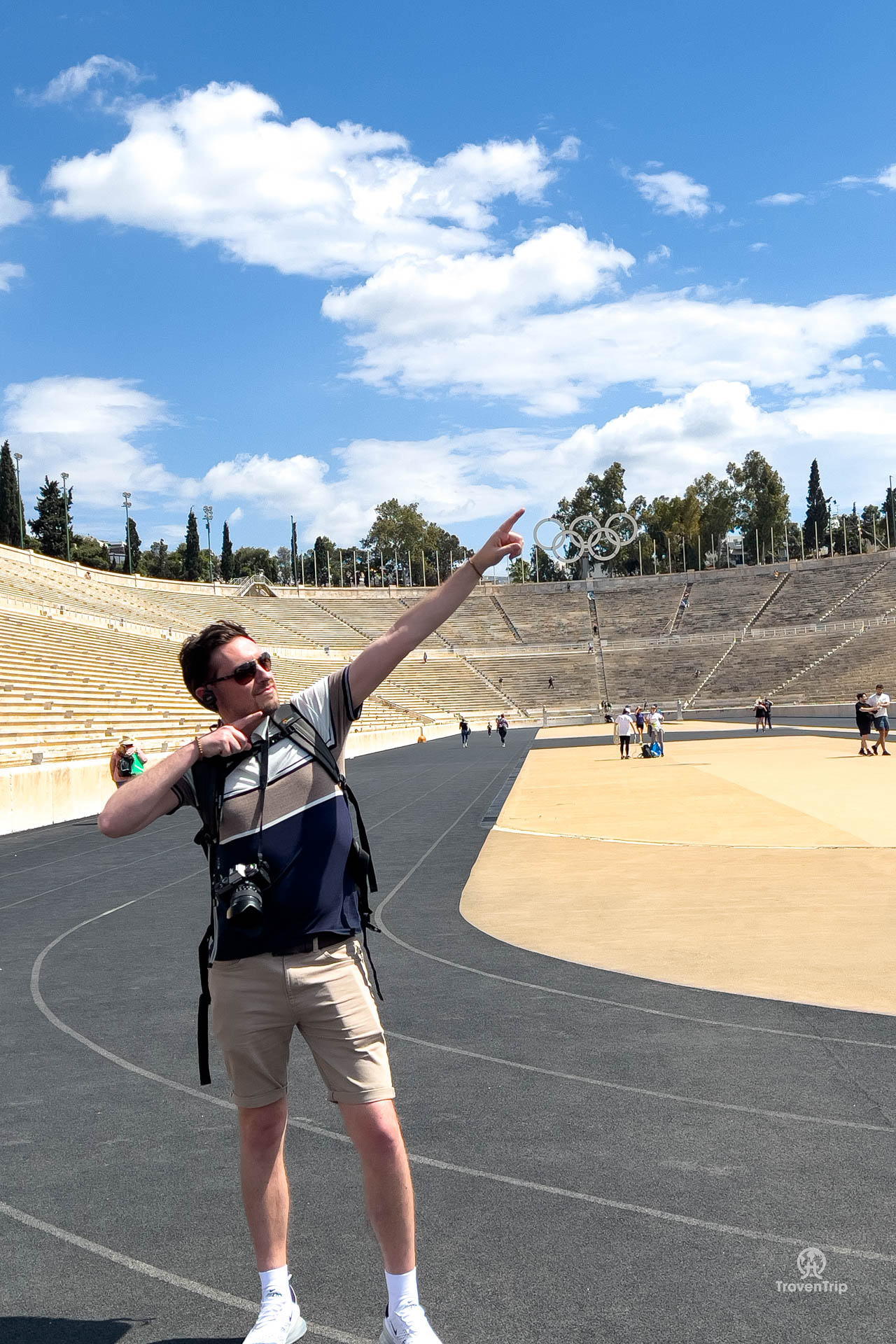 Paul's best Usain Bolt impression
Paul's best Usain Bolt impression 
 The Greece and Olympic flags
The Greece and Olympic flags  Great views of the games from the top!
Great views of the games from the top!  And great views beyond too!
And great views beyond too! 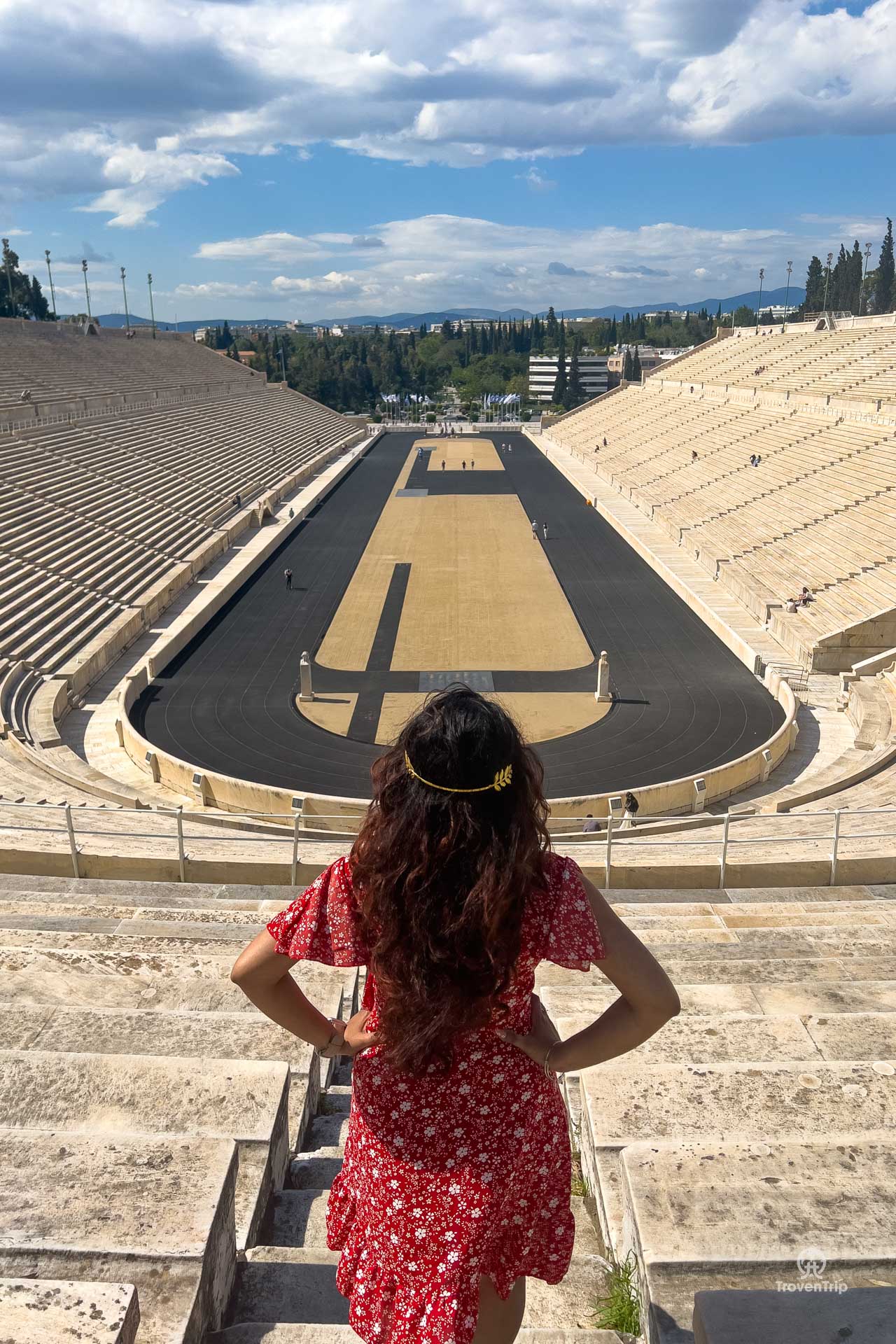

Hidden away inside the stadium there's also a small museum which we go and explore, with displays of the Olympic posters and flames from each of the modern Olympic Games. And it's here that our tour ends and we say goodbye to Sophia, who has been a fantastic guide, showing us the sites and telling us the stories of this ancient city, helping us to make the most of our day in Athens.
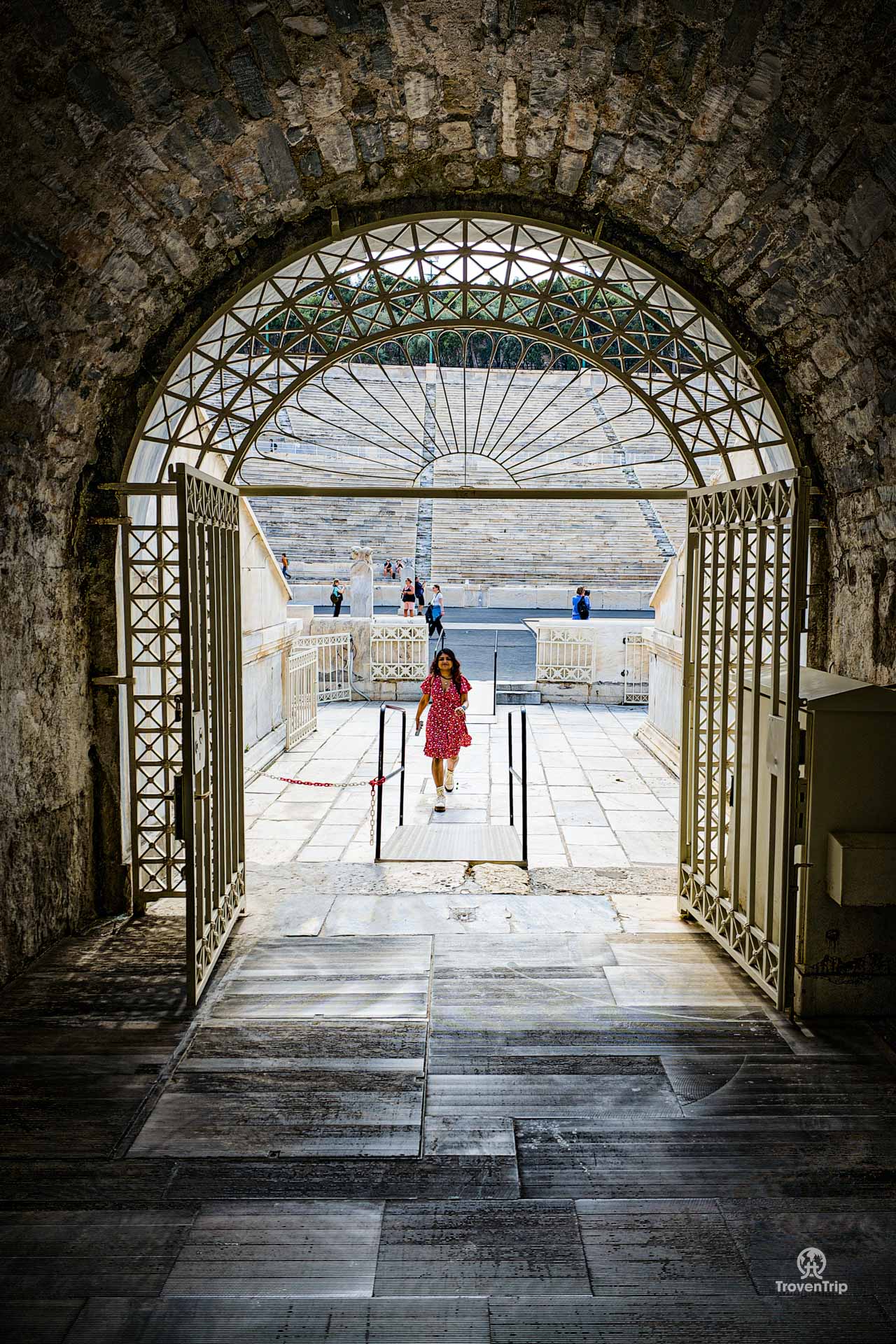 The entrance to the stadium which the first modern Olympians would have walked through
The entrance to the stadium which the first modern Olympians would have walked through  Looking up the tunnel towards the museum
Looking up the tunnel towards the museum 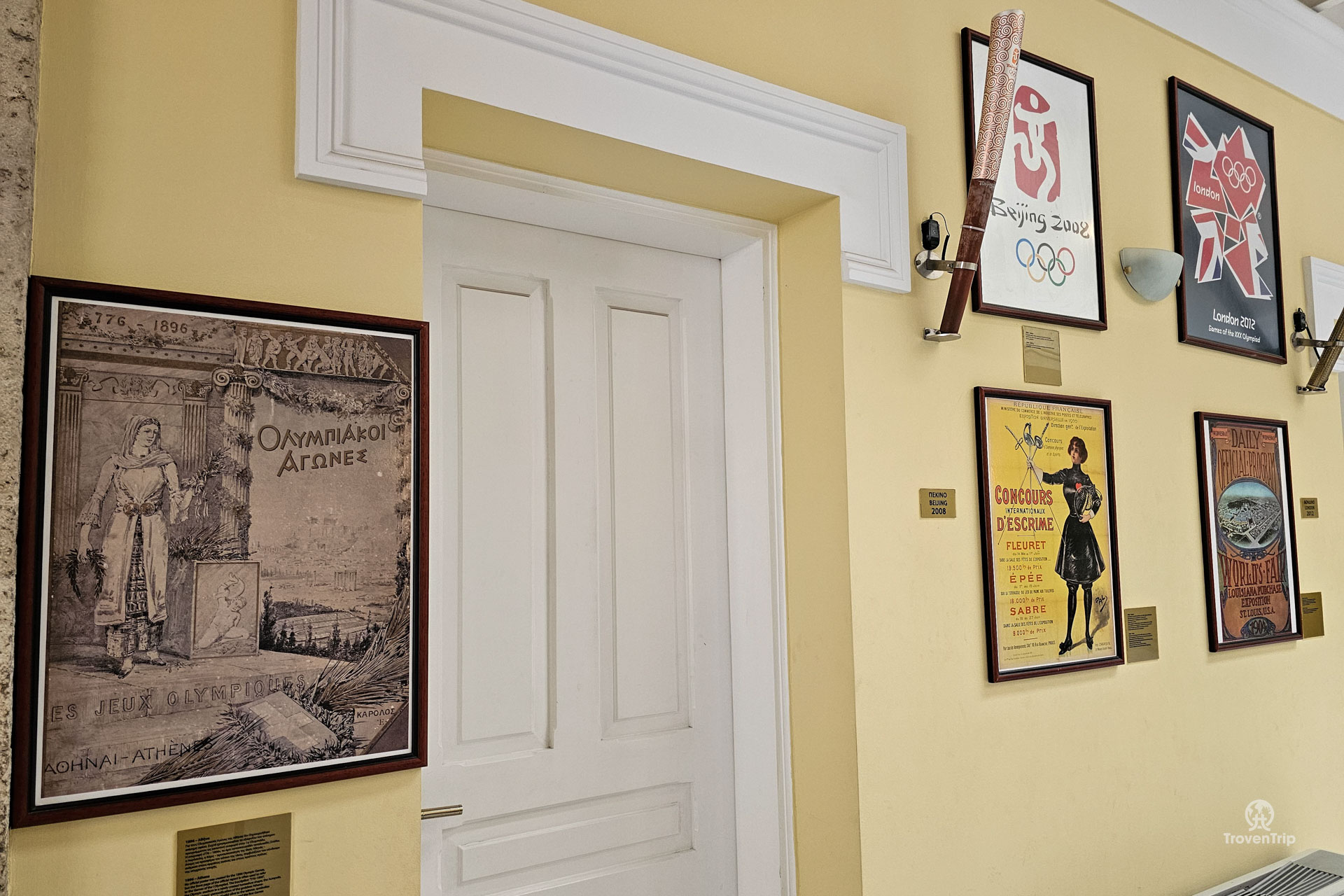 The very first poster and the London 2012 games
The very first poster and the London 2012 games  The museum room with all of the posters and flames
The museum room with all of the posters and flames Zappeion Hall and Gardens
The tour may be over but our history isn't quite done yet... despite our feet aching after a long day of walking, we walk back into town, making a stop at Zappeion Hall and gardens... an old manor house which housed the Olympians of the first modern Olympic Games.
The hall is close to the stadium and we passed it on our way there so you won't miss it... today it's used as a conference centre and you can walk inside the internal courtyard and explore the gardens in your own time as we do.
 An impressive entrance for the 19th century Olympians
An impressive entrance for the 19th century Olympians  The inside courtyard
The inside courtyard  Looking up!
Looking up! Shopping in Plaka Old Town
As we wandered the streets of Plaka earlier, we couldn't help but window shop and see all sorts of things for sale. From the usual souvenirs in the tourist shops, to Greek made clothes and jewellery in high-end boutiques, there is a great choice of gifts to pick up for either yourself or your loved ones.
So with our history done for the day, we head to the shops and do some Greek shopping (surprise surprise, Sneha wants to shop!), until our feet can't take it anymore (or Paul's can't anyway!) and we need to sit down for a while.
 Beautiful handmade pots
Beautiful handmade pots  Plaka at night
Plaka at night  All of the shops had a huge assortment of the Greek Gods
All of the shops had a huge assortment of the Greek Gods  And lot of chess sets too
And lot of chess sets too  Not sure how's we explain this at the airport...
Not sure how's we explain this at the airport... On the tour we walked along Tripodon, one of the oldest streets in Europe, and saw Erechtheos, a photo famous alleyway lined with cafés. "Let's go there" Paul says, but then manages to get a bit lost in trying to find it again (link added so you can find it easier than Paul!)
After a while of scouring Google maps we find the café we want, and we just about make it before collapsing into the comfy chairs to rest and refuel.
Melina Mercouri Café in Plaka
One of the best spots to sit, soak up the atmosphere, and people watch is Melina Mercouri Café. We strike lucky and get a table on the terrace straight away, sitting up at the top of the alleyway with a great vantage point of everything happening around us.
Paul orders what soon becomes his go to pick-me-up (which still confuses Sneha)... a Greek coffee and beer. While Sneha goes for a coffee liqueur cocktail. Caffeine and alcohol... just what we need to unwind and relax without actually falling asleep!
As we sit and enjoy our drinks, small sparrows flutter all around us, chasing crisp crumbs as they fall on the floor from surrounding tables. Tourists and locals stream past talking away, cameras and shopping bags in hand. And the café and alleyway are beautiful, bright vibrant flowers and trees adorn the outside, while the interior is a cosy and traditional taverna dedicated to the Greek actress, singer and politician Melina Mercouri.
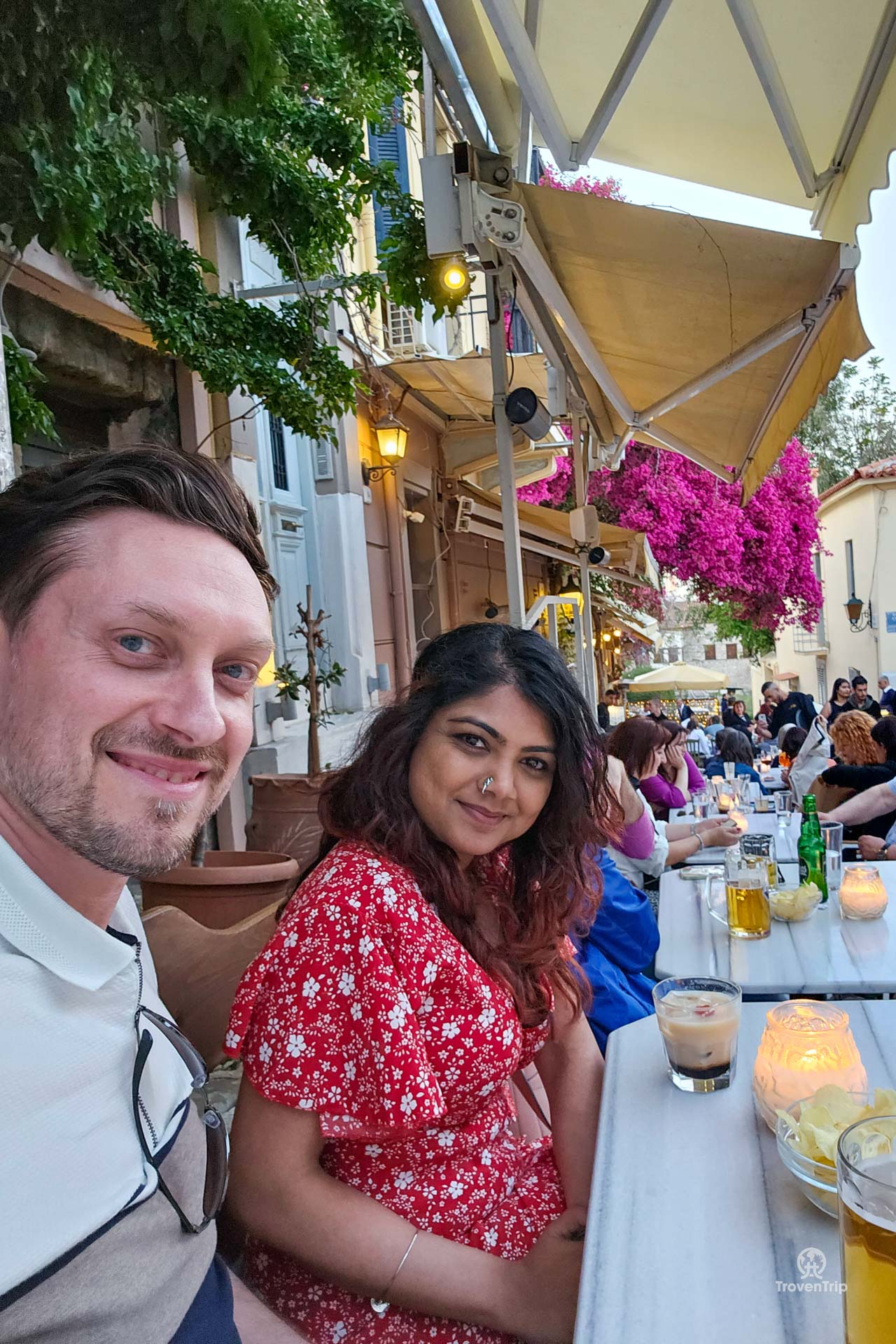 And time to relax!
And time to relax! 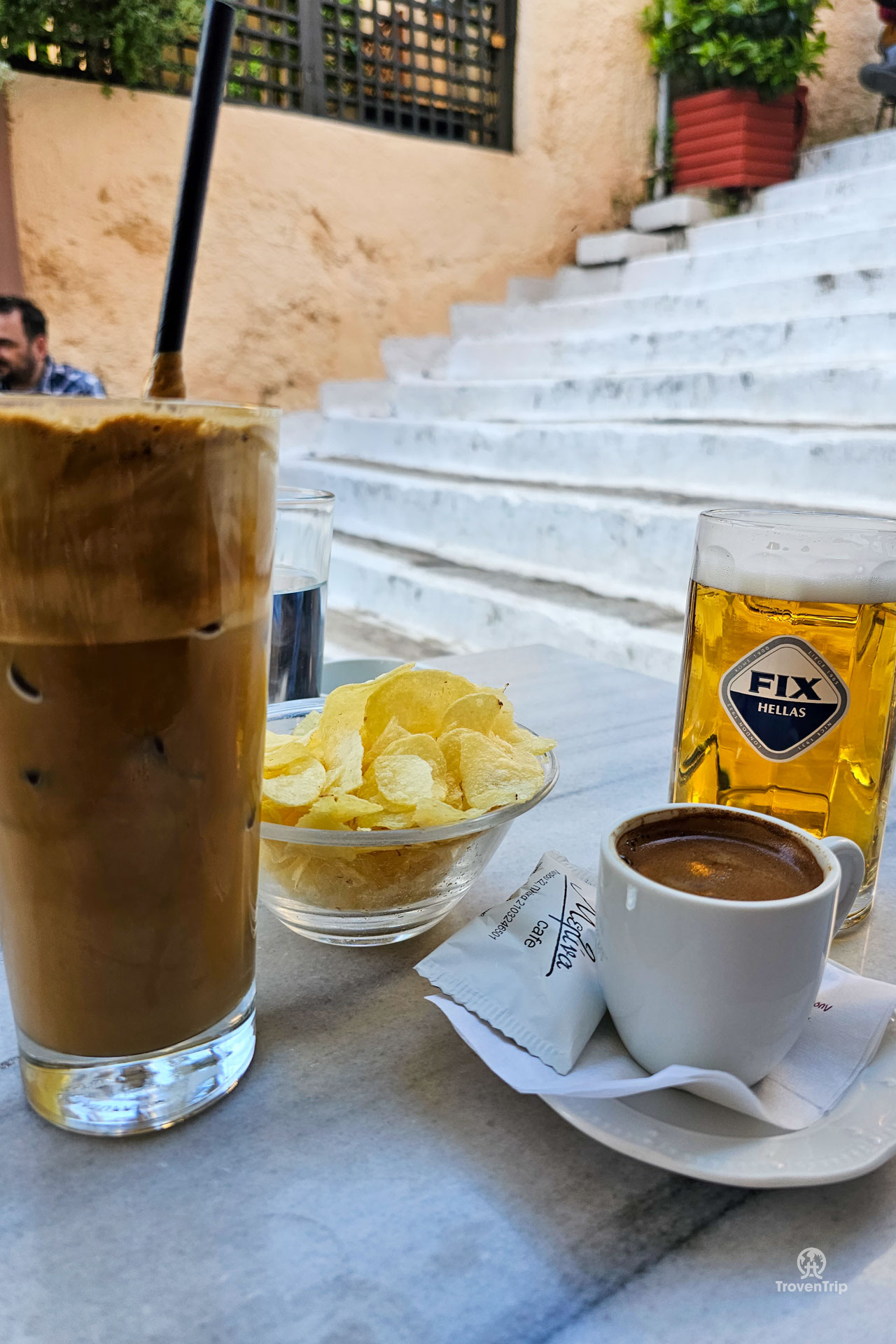 A perfect pick-me-up after a long day of sight-seeing... caffeine and alcohol!
A perfect pick-me-up after a long day of sight-seeing... caffeine and alcohol!  The very pretty Erechtheos
The very pretty Erechtheos  Melina Mercouri Café, very different inside than out!
Melina Mercouri Café, very different inside than out! 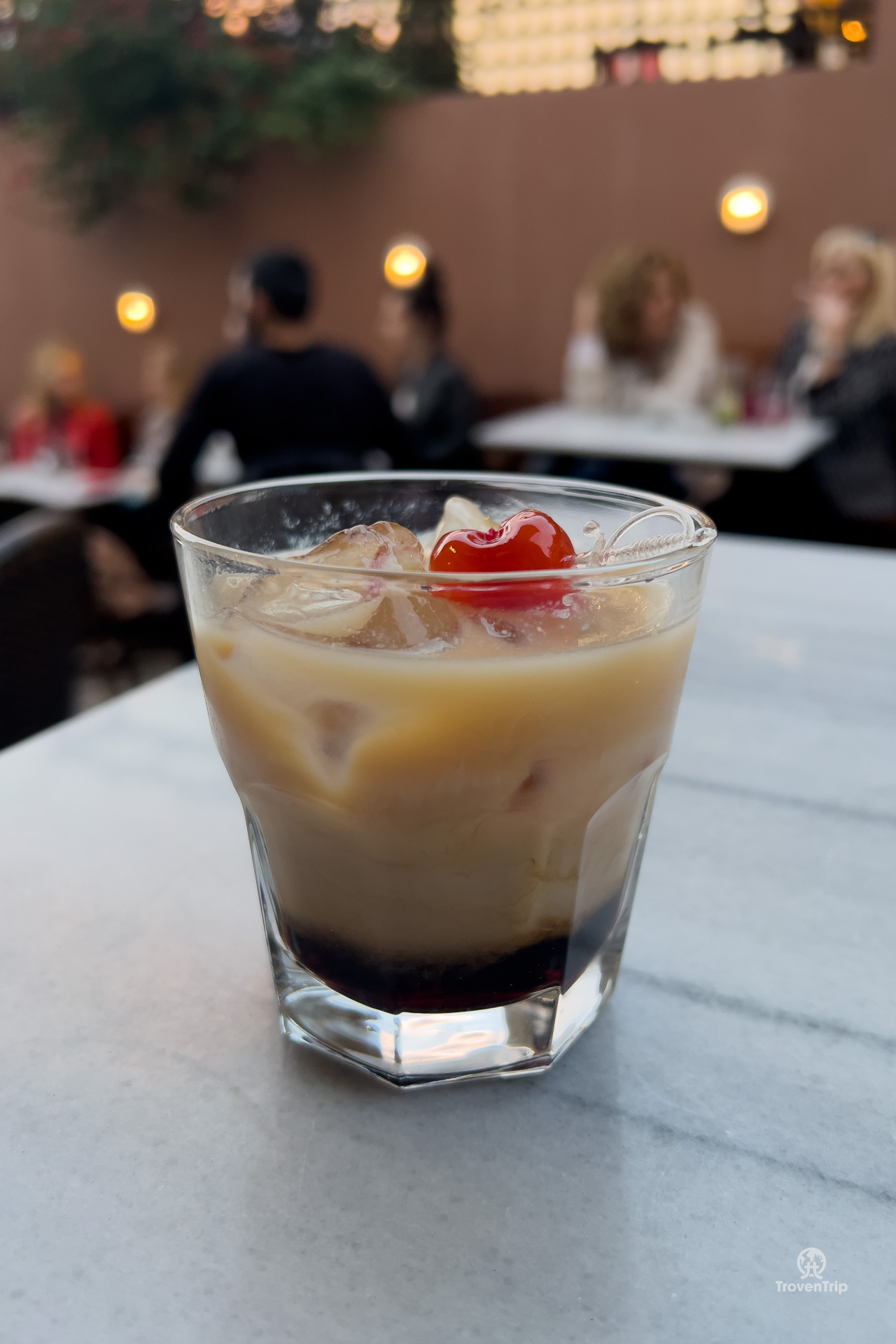 Sneha's B52 cocktail
Sneha's B52 cocktail Rooftop Bars in Athens
We make our way back to Monastiraki Square after some final late night shopping, and go for drinks at Attic Urban Rooftop bar.
In a history filled day history seems to be repeating itself... our day starting and ending with breath-taking views of the Acropolis, and our skip the line tickets seeming to even work here, as we're shown to the best table in the bar ahead of the waiting queue (meaning we get some strange looks from the waiting locals!)
We're not quite sure how we managed to do everything we have all in one day, but it feels good to relax, sit back, and enjoy some nice cocktails admiring the view...
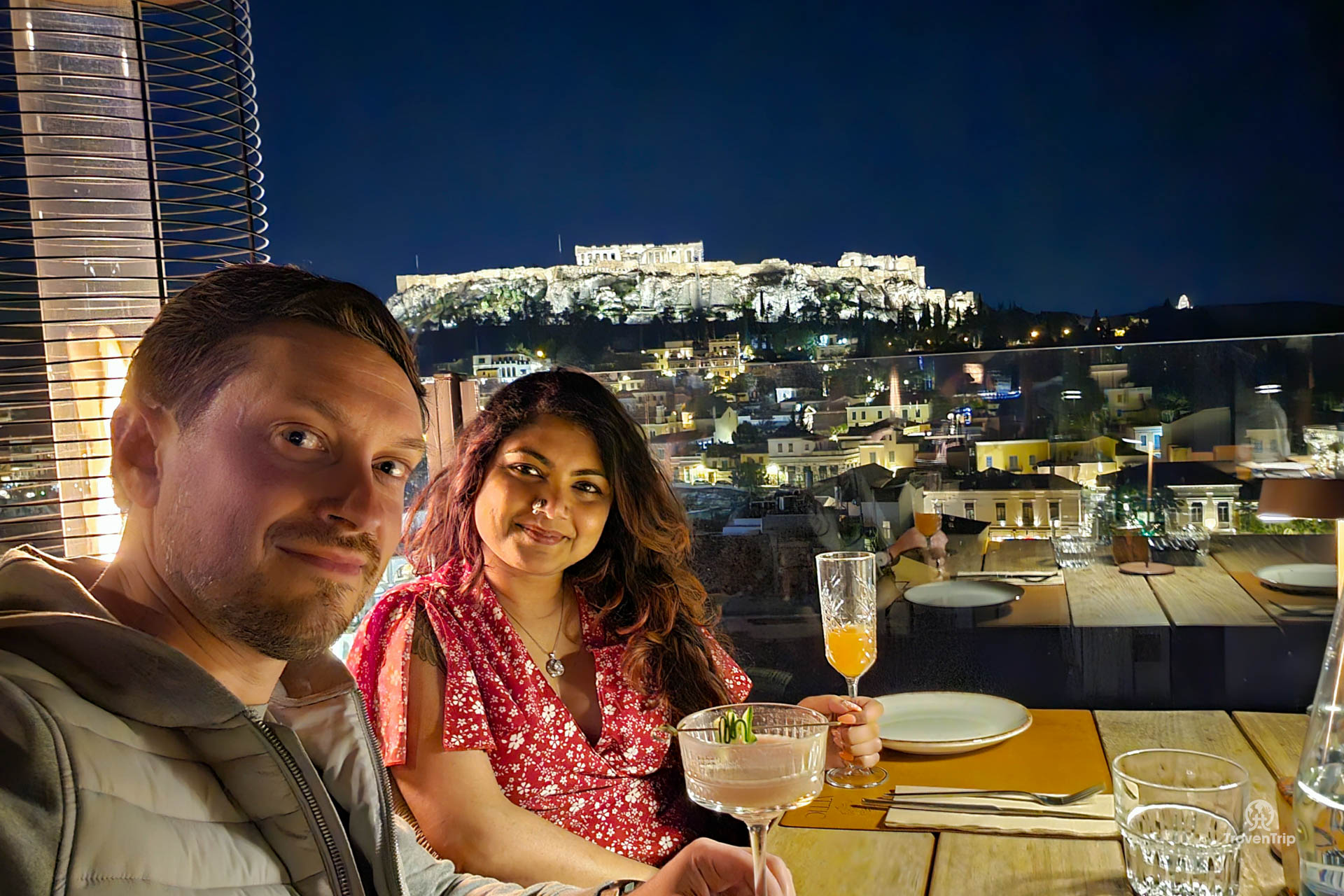 Cocktails with a view
Cocktails with a view 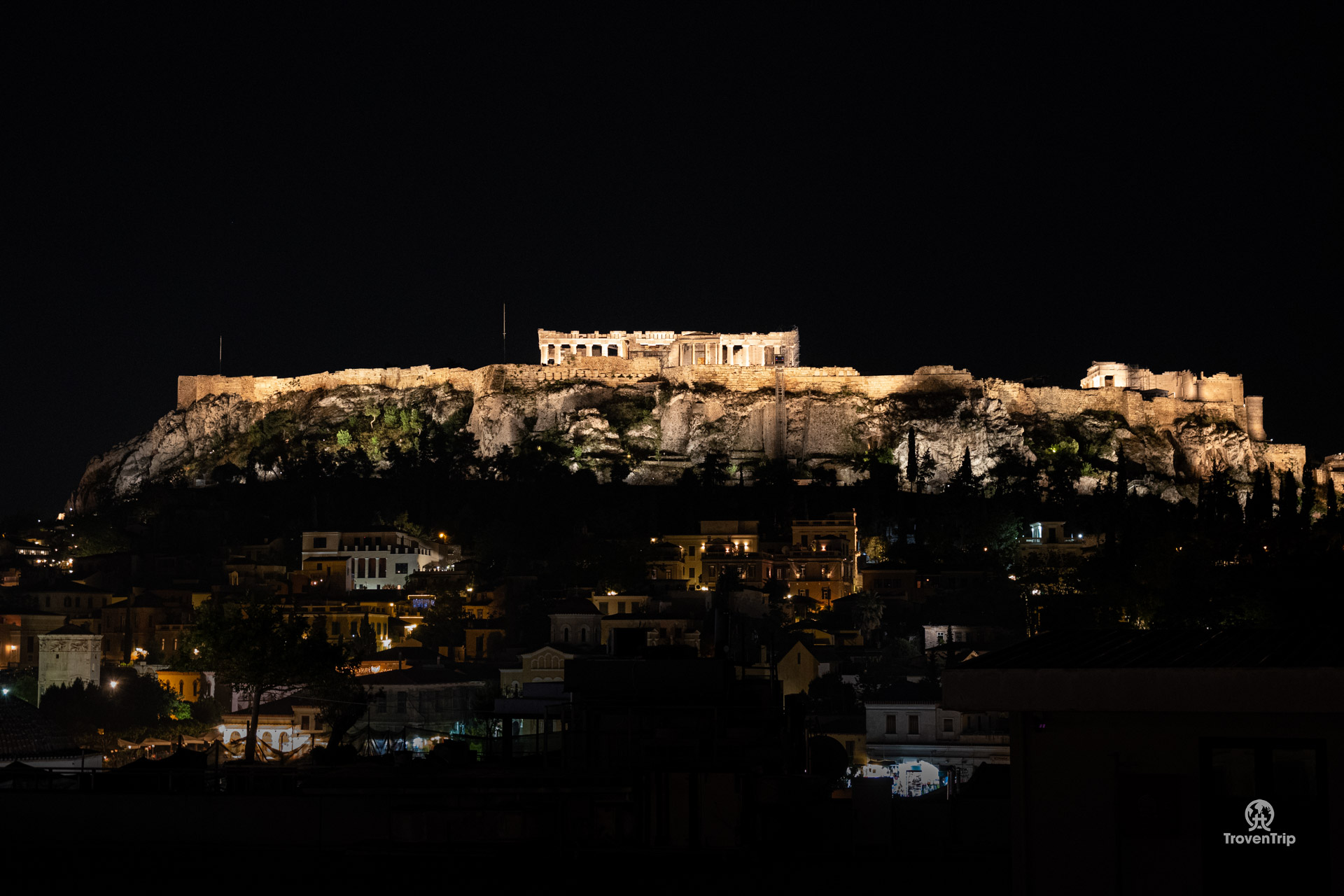 And what a view!
And what a view! 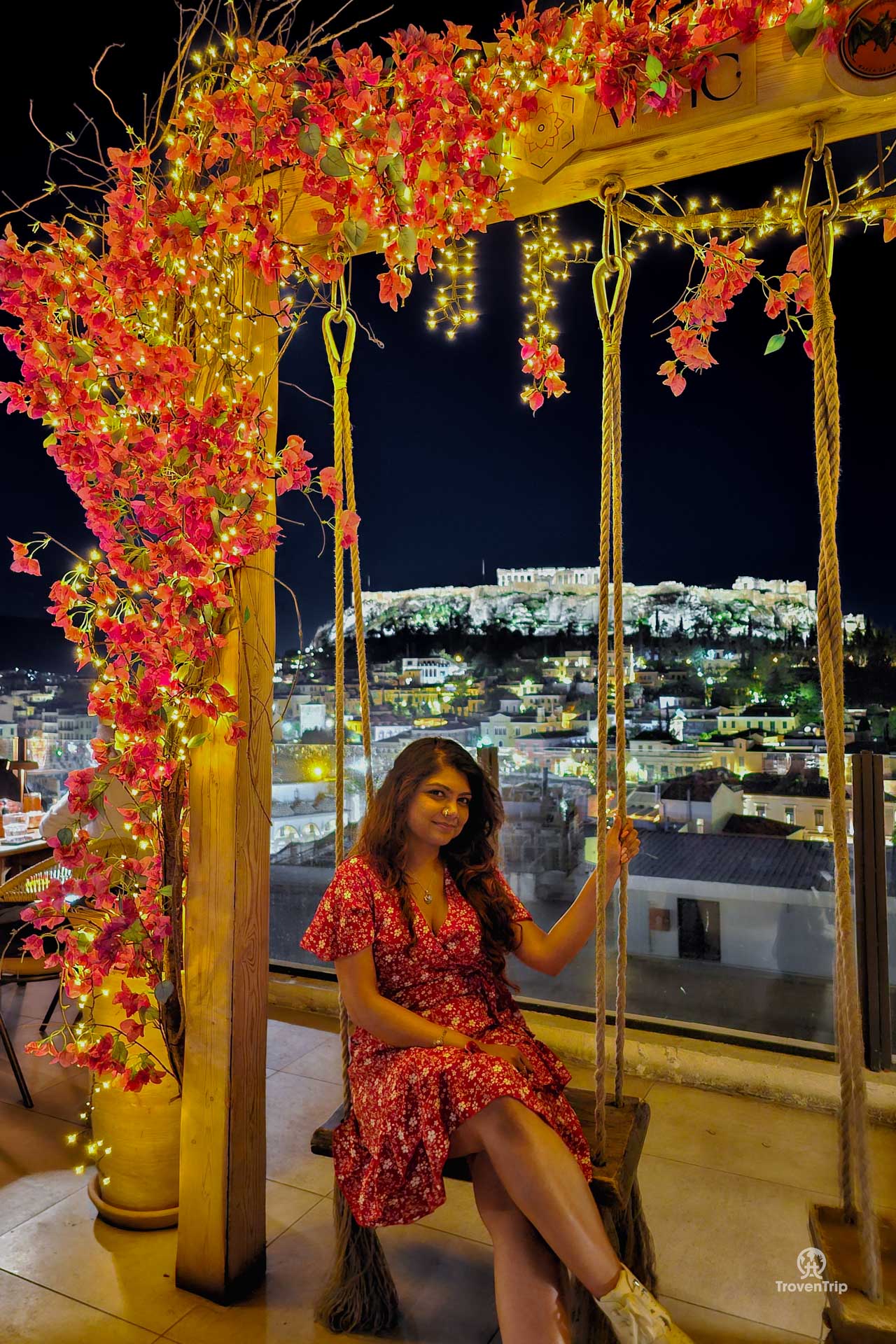 Perfect Instagram spot!
Perfect Instagram spot!  Even at night Monastiraki Square was buzzing
Even at night Monastiraki Square was buzzing  Looking up at the rooftop bars from the square
Looking up at the rooftop bars from the square 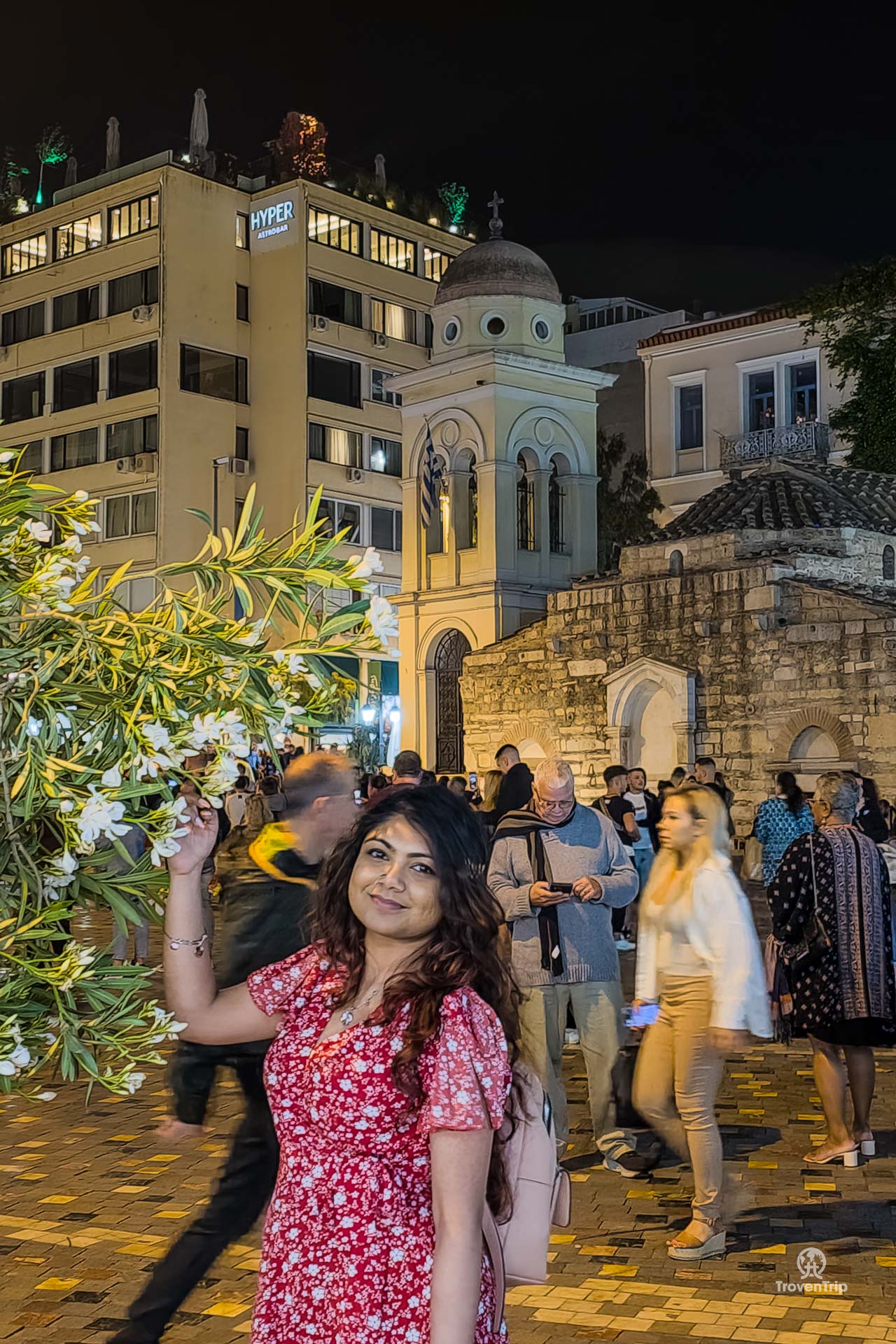
Troven Moments
Visiting the Acropolis and Parthenon and immersing ourselves in thousands of years of history on our Walks tour, and seeing one of the most iconic Wonders of the World up-close was a once in a lifetime experience.
Wandering the streets of Plaka, shopping in the souvenir shops, and relaxing in the cafés was a great way to unwind and rest our feet after lots of walking seeing the sights.
And enjoying souvlaki in the tavernas and ending the night drinking cocktails on a rooftop bar with jaw-dropping views of the Acropolis at night was the perfect way to end our day.
TrovenTripper's Tips
Anyone who follows our blogs will know we always try and fit in as much as possible into one day when travelling, and so joining the Athens In a Day Tour by Walks was the perfect way for us to do this! Driving around Athens and finding a reliable parking spot can be a nightmare, so best is to just explore on foot or take the metro, buses or trams to get around.
Be careful if catching a taxi... agree on the amount before you step in, or make sure you ask them to turn on the meter. We (i.e. Paul) forgot to do this to his cost!
We had a lot of walking and sight-seeing before our lunch break on the tour, so make sure you carry some refreshments with you. A water bottle is a must as it can get very hot and sunny, and there is a water-filling station at the top of the Acropolis.
 It was pretty windy at the top, hence the windswept look!
It was pretty windy at the top, hence the windswept look!  Our amazing guide Sofia!
Our amazing guide Sofia! Walks Tours
Our visit included a sponsored tour provided by Walks, which you can book yourself here... Athens In a Day Tour.
This post has affiliate links, meaning we may earn a small commission if you click the link and proceed with a purchase at no cost to you. We were hosted by Walks, and only recommend experiences, hotels, products, and services we use and support ourselves, and we always give a true and honest account of our experience.
While organised tours aren't often our thing, without it we would never have been able to see Athens in a day and make the most of our visit. Taking the tour meant we could take all of the short-cuts around the city to make the most of our time, and our guide Sofia was great in telling us the history of each site we visited, providing us an interesting and local view we wouldn't have got by exploring the city ourselves.
Walks provide walking tours in most of the major cities and attractions in Europe and North America, and although this was our first experience of one, we're sure it won't be the last!
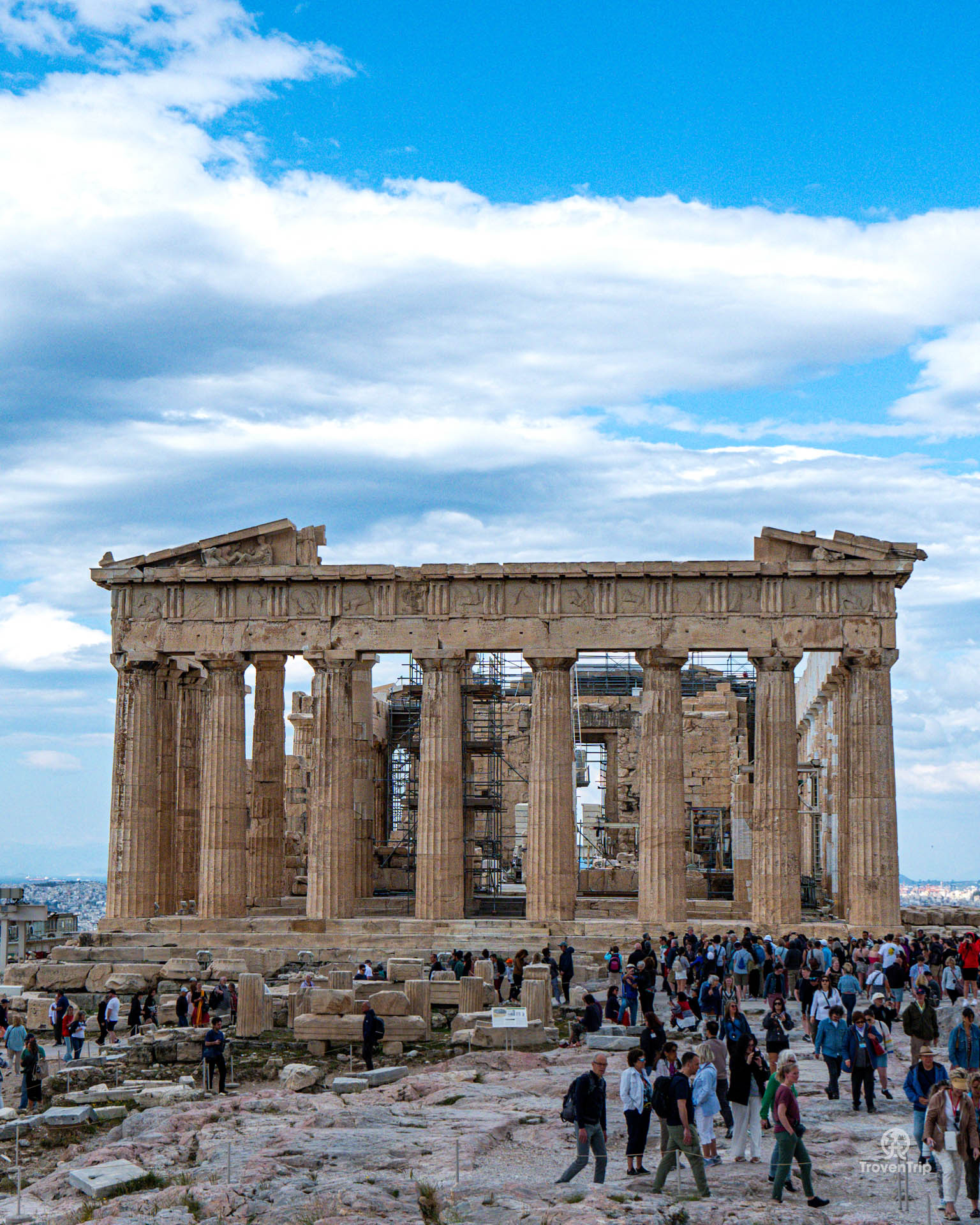

2 comments
Great photos! And I definitely spotted the Lego pieces on the Monumental Gateway!
Thanks. Yeah the Lego pieces are quite cool aren't they!
Relateable posts
-
blog
-
Greece
Aug 20, 2023The 10 Best Places to Visit in the Peloponnese, Greece
Are you looking for the best places to visit in the Peloponnese, Greece? How long…
-
blog
-
Greece
Aug 19, 2023Visiting Meteora and Exploring the Ancient Monasteries
Do you only have a short amount of time on mainland Greece and wondering is…